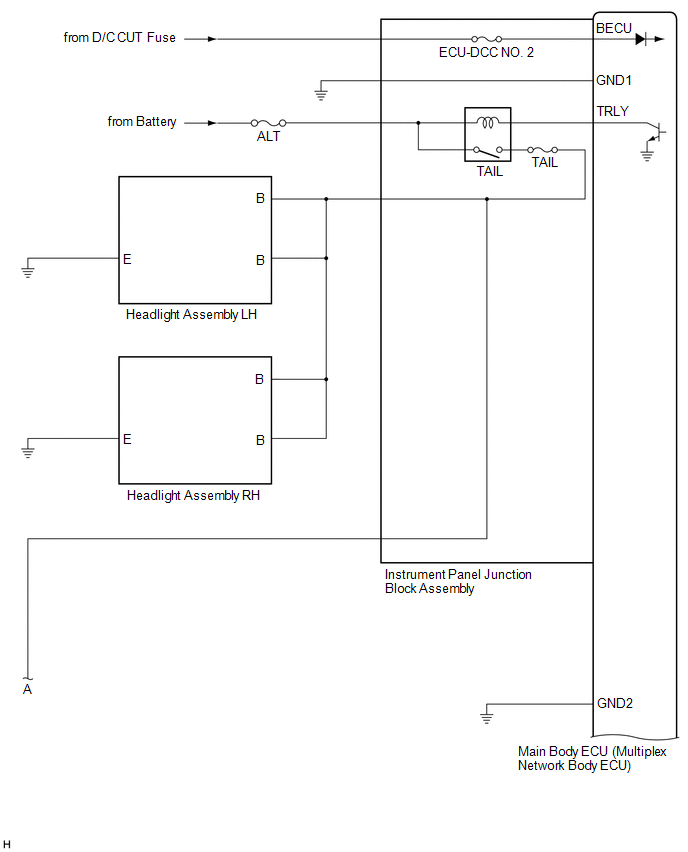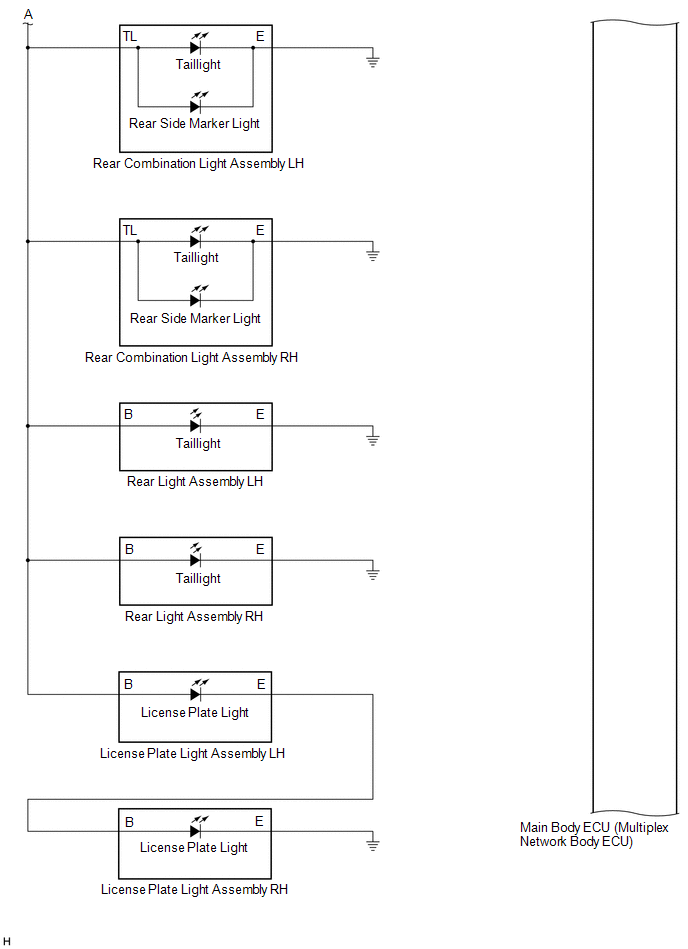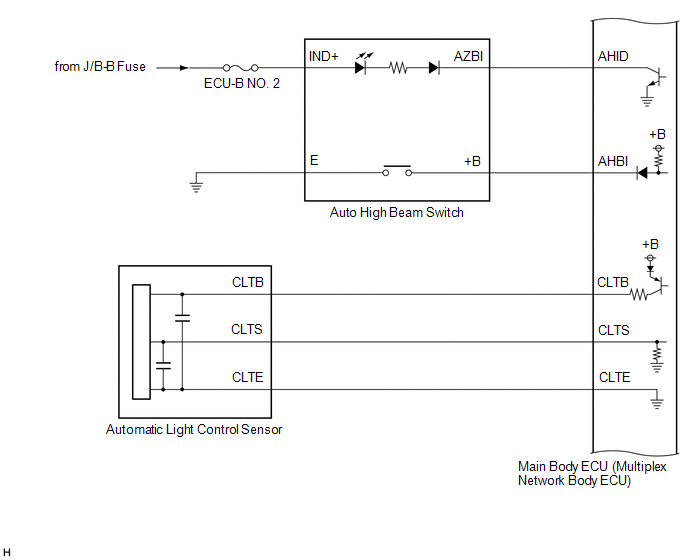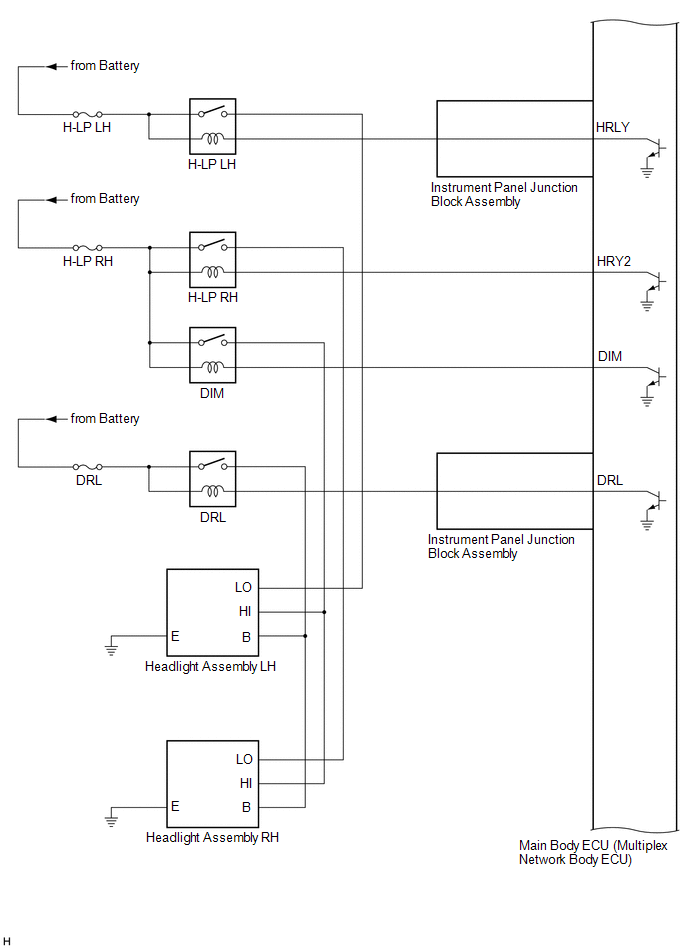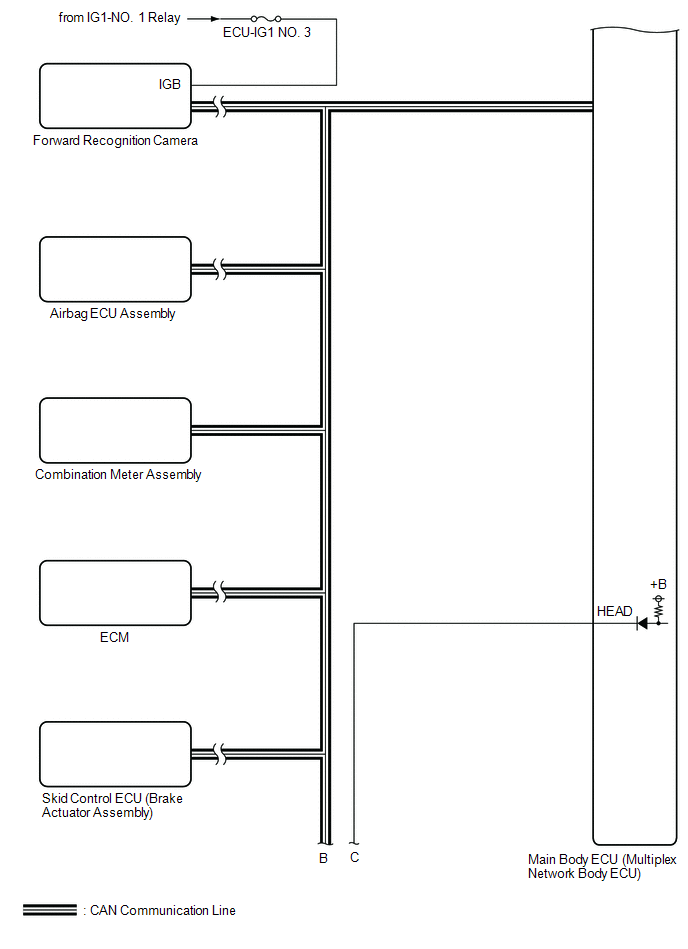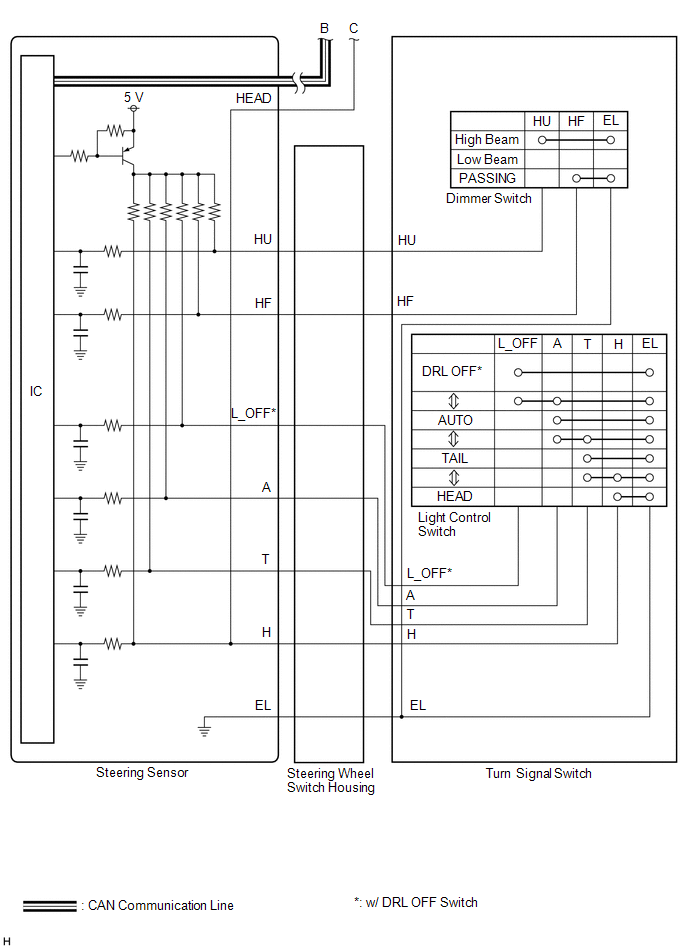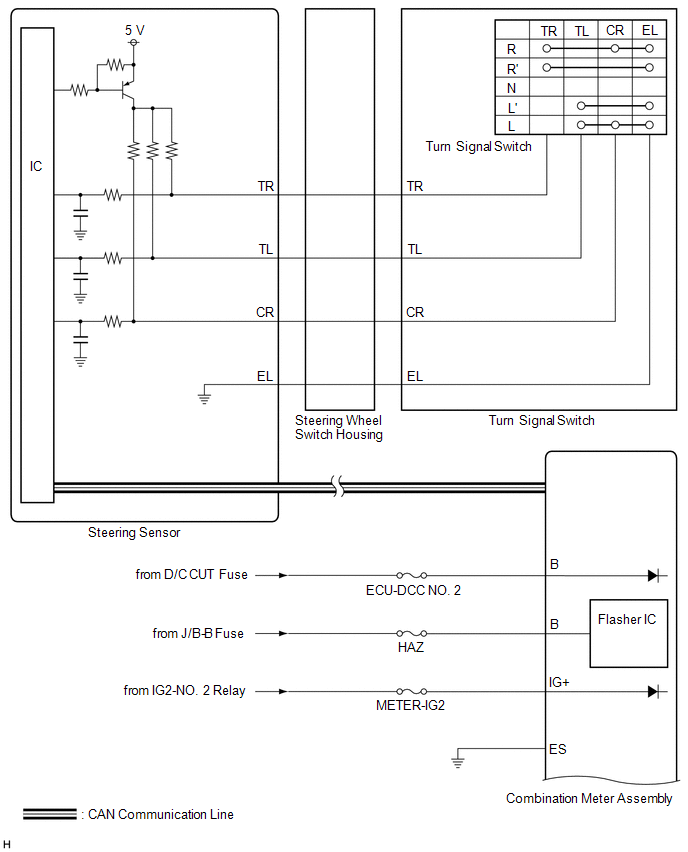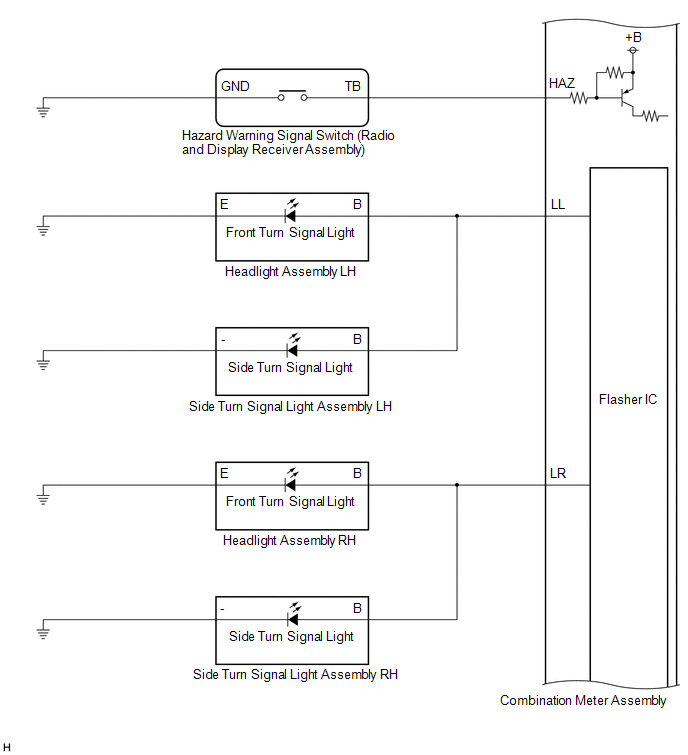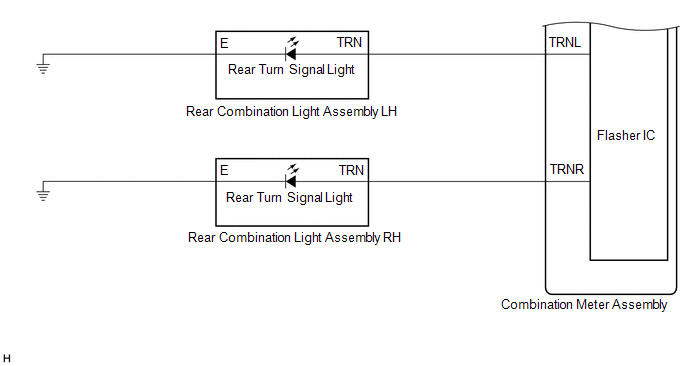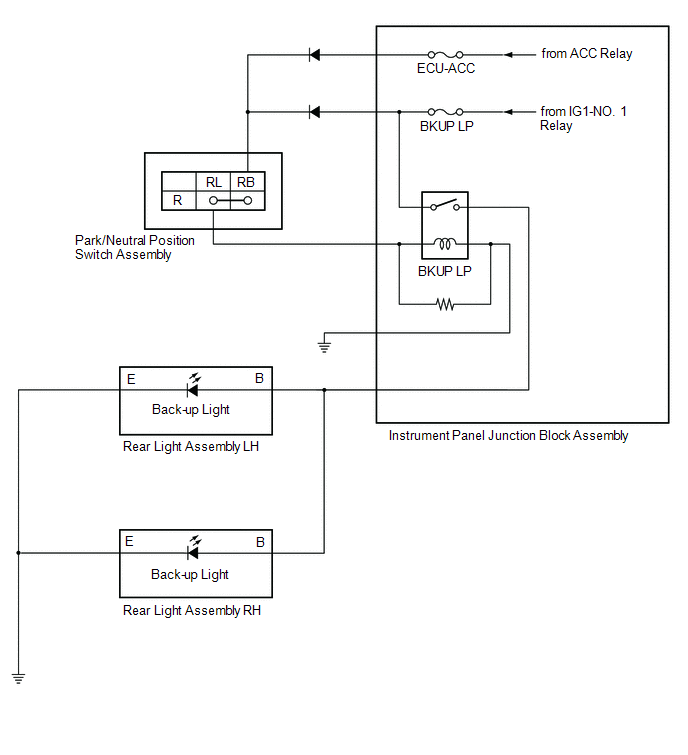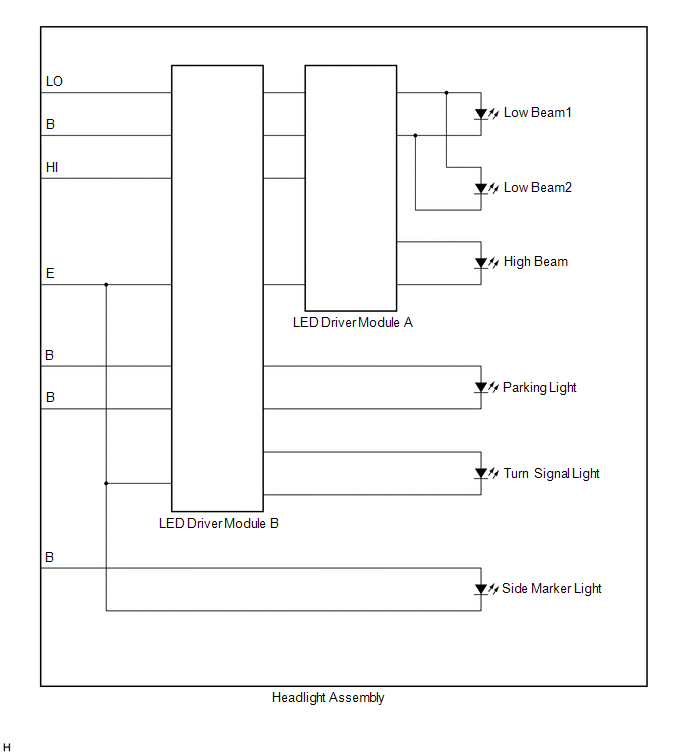Automatic High Beam Switch Indicator does not Come ON
DESCRIPTION
When the
automatic high beam system is on, the main body ECU (multiplex network
body ECU) illuminates the auto high beam switch indicator.
WIRING DIAGRAM
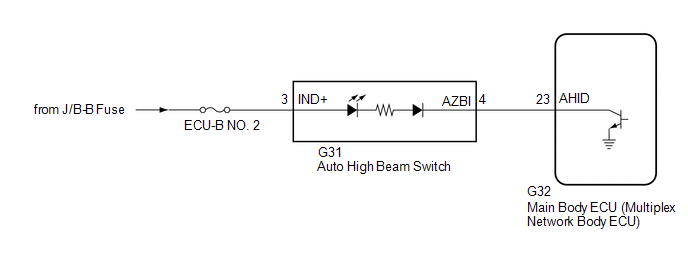
CAUTION / NOTICE / HINT
NOTICE:
- Inspect the fuses for circuits related to this system before performing the following procedure.
- Before replacing the main body ECU (multiplex network body ECU), refer to Registration.
Click here 
PROCEDURE
|
1. | PERFORM ACTIVE TEST USING TECHSTREAM |
(a) Connect the Techstream to the DLC3.
(b) Turn the engine switch on (IG).
(c) Turn the Techstream on.
(d) Enter the following menus: Body Electrical / Main Body / Active Test.
(e) Perform the Active Test according to the display on the Techstream.
Body Electrical > Main Body > Active Test
|
Tester Display | Measurement Item |
Control Range | Diagnostic Note |
|
Automatic High Beam Switch Light |
Auto high beam switch indicator light |
OFF or ON | - |
Body Electrical > Main Body > Active Test
|
Tester Display |
| Automatic High Beam Switch Light |
OK:
Auto high beam switch indicator light illuminates.
| OK |
 | USE SIMULATION METHOD TO CHECK |
|
NG |
 | |
| 2. |
INSPECT AUTO HIGH BEAM SWITCH |
(a) Remove the auto high beam switch.
Click here 
(b) Inspect the auto high beam switch.
Click here 
| NG |
 | REPLACE AUTO HIGH BEAM SWITCH |
|
OK |
 | |
| 3. |
CHECK HARNESS AND CONNECTOR (POWER SOURCE - AUTO HIGH BEAM SWITCH) |
(a) Measure the voltage according to the value(s) in the table below.
Standard Voltage:
|
Tester Connection | Condition |
Specified Condition |
|
G31-3 (IND+) - Body ground |
Always | 11 to 14 V |
| NG |
 | REPAIR OR REPLACE HARNESS OR CONNECTOR |
|
OK |
 | |
| 4. |
CHECK HARNESS AND CONNECTOR (AUTO HIGH BEAM SWITCH - MAIN BODY ECU (MULTIPLEX NETWORK BODY ECU)) |
(a) Disconnect the G32 main body ECU (multiplex network body ECU) connector.
(b) Measure the resistance according to the value(s) in the table below.
Standard Resistance:
|
Tester Connection | Condition |
Specified Condition |
|
G31-4 (AZBI) - G32-23 (AHID) |
Always | Below 1 Ω |
|
G31-4 (AZBI) or G32-23 (AHID) - Body ground |
Always | 10 kΩ or higher |
| OK |
 | REPLACE MAIN BODY ECU (MULTIPLEX NETWORK BODY ECU) |
| NG |
 | REPAIR OR REPLACE HARNESS OR CONNECTOR |
Automatic High Beam System does not Operate or Operation Indicator does not Illuminate
DESCRIPTION
The main body
ECU (multiplex network body ECU) controls the automatic high beam system
based on signals received from the forward recognition camera.
WIRING DIAGRAM
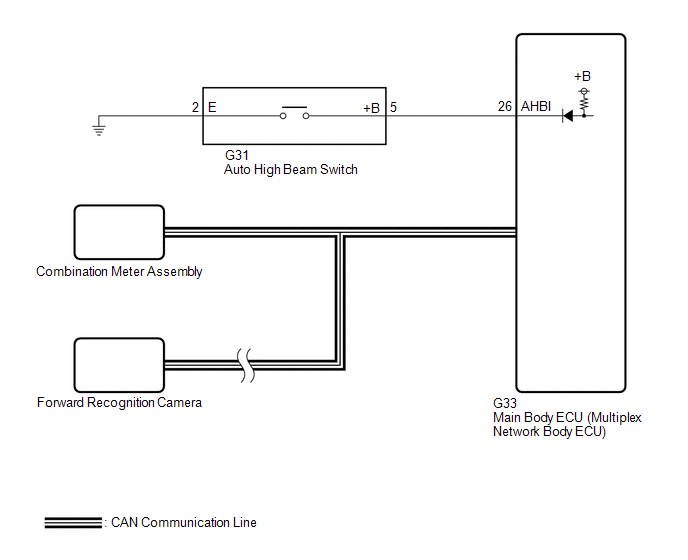
CAUTION / NOTICE / HINT
NOTICE:
- Before replacing the main body ECU (multiplex network body ECU), refer to Registration.
Click here 
- When replacing the forward recognition camera, always replace it with a
new one. If a forward recognition camera which was installed to another
vehicle is used, the information stored in the forward recognition
camera will not match the information from the vehicle. As a result, a
DTC may be stored.
- If the forward recognition camera has been replaced with a new one, be sure to perform Forward Recognition Camera Learning.
Click here 
- Before performing troubleshooting, check that the low beam headlights and high beam headlights illuminate correctly.
- When replacing the combination meter assembly, always replace it with a
new one. If a combination meter assembly which was installed to another
vehicle is used, the information stored in it will not match the
information from the vehicle and a DTC may be stored.
- When the forward recognition camera cannot correctly detect objects due
to inclement weather such as thick fog or other visual obstructions, the
automatic high beam indicator may not turn on and consequently the
automatic high beam system may not operate.
- Before performing troubleshooting, check that the pre-collision system DTCs are not output.
Click here 
PROCEDURE
|
1. | READ VALUE USING TECHSTREAM |
(a) Connect the Techstream to the DLC3.
(b) Turn the engine switch on (IG).
(c) Turn the Techstream on.
(d) Enter the following menus: Chassis / Front Recognition Camera / Data List.
(e) Read the Data List according to the display on the Techstream.
Chassis > Front Recognition Camera > Data List
|
Tester Display | Measurement Item |
Range | Normal Condition |
Diagnostic Note |
|
High Temperature Status1 |
High temperature malfunction status |
OFF or ON | OFF: Forward recognition camera high temperature malfunction does not exist
ON: Forward recognition camera high temperature malfunction exists |
- |
Chassis > Front Recognition Camera > Data List
|
Tester Display |
| High Temperature Status1 |
OK:
"OFF" is displayed on the Techstream.
HINT:
If
"ON" is displayed, move the vehicle to a cool place and allow the
temperature of the forward recognition camera to decrease before
continuing with troubleshooting.
| NG |  |
END (TEMPORARY SUSPENSION OF AUTOMATIC HIGH BEAM SYSTEM DUE TO HIGH FORWARD RECOGNITION CAMERA TEMPERATURE) |
|
OK |
 | |
| 2. |
CHECK AUTOMATIC HIGH BEAM INDICATOR LIGHT |
(a) Check the operation of the automatic high beam indicator light.
(1) Turn the engine switch on (IG).
(2) Turn the light control switch to the AUTO or head position.
(3) Cover the automatic light control sensor to turn the low beam headlights on.
(4) Move the dimmer switch to the high position.
(5) Press the auto high beam switch.
|
Result | Proceed to |
|
OK (The automatic high beam indicator light and the auto high beam switch indicator illuminate) |
A |
| NG (Automatic high beam indicator light does not illuminate) |
B |
| NG (Auto high beam switch indicator does not illuminate) |
C |
| NG (Automatic high beam indicator light and auto high beam switch indicator do not operate) |
D |
| B |
 | GO TO STEP 5 |
| C |
 | GO TO OTHER PROBLEM (Proceed to Automatic High Beam Switch Indicator does not Come ON) |
| D |
 | GO TO STEP 6 |
|
A |
 | |
| 3. |
READ VALUE USING TECHSTREAM |
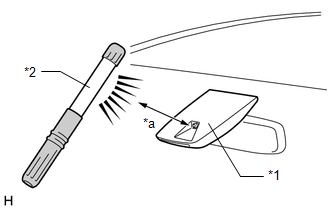
|
*1 | Forward Recognition Camera
(Automatic High Beam Sensor) |
|
*2 | Work Light or Equivalent |
|
*a | 100 mm or less |
(a) Shine a light on the automatic high beam sensor.
HINT:
If
troubleshooting is being performed in a bright area, such as outside on
a sunny day, it will not be necessary to perform this step.
(b) Connect the Techstream to the DLC3.
(c) Turn the engine switch on (IG).
(d) Turn the Techstream on.
(e) Enter the following menus: Body Electrical / Main Body / Data List.
(f) Read the Data List according to the display on the Techstream.
HINT:
As it may take time for the values in the Data List to change, wait at least 10 seconds before reading the Data List.
Body Electrical > Main Body > Data List
|
Tester Display | Measurement Item |
Range | Normal Condition |
Diagnostic Note |
|
Auto H Beam STS0 | Automatic high beam sensor current state |
Undetec, CAM NA, No sens, Hlight, Taillgt, Speed, Daytime, Village, Malfunc, Delay, Aim Lmt, SAE Mod, Undefin or LIN Err |
Condition can be displayed |
- |
Body Electrical > Main Body > Data List
|
Tester Display |
| Auto H Beam STS0 |
OK:
"Daytime" is displayed on the Techstream.
| NG |
 | REPLACE FORWARD RECOGNITION CAMERA |
|
OK |
 | |
| 4. |
READ VALUE USING TECHSTREAM |
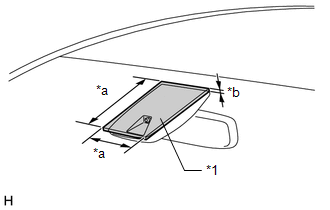
|
*1 | Cardboard or Equivalent Object |
|
*a | 150 mm or more |
|
*b | 3 mm or more |
(a) Cover the automatic high beam sensor with an opaque object, such as cardboard.
NOTICE:
- Make sure that there is no clearance between the cardboard or equivalent
object and the area of the windshield glass in front of the automatic
high beam sensor.
- If there is any clearance, light may shine on the automatic high beam sensor and the value of the Data List will not change.
(b) Connect the Techstream to the DLC3.
(c) Turn the engine switch on (IG).
(d) Turn the Techstream on.
(e) Enter the following menus: Body Electrical / Main Body / Data List.
(f) Read the Data List according to the display on the Techstream.
HINT:
As it may take time for the values in the Data List to change, wait at least 10 seconds before reading the Data List.
Body Electrical > Main Body > Data List
|
Tester Display | Measurement Item |
Range | Normal Condition |
Diagnostic Note |
|
Auto H Beam STS0 | Automatic high beam sensor current state |
Undetec, CAM NA, No sens, Hlight, Taillgt, Speed, Daytime, Village, Malfunc, Delay, Aim Lmt, SAE Mod, Undefin or LIN Err |
Condition can be displayed |
- |
Body Electrical > Main Body > Data List
|
Tester Display |
| Auto H Beam STS0 |
OK:
"Speed" is displayed on the Techstream.
| OK |
 | USE SIMULATION METHOD TO CHECK |
| NG |
 | REPLACE FORWARD RECOGNITION CAMERA |
| 5. |
PERFORM ACTIVE TEST USING TECHSTREAM |
(a) Connect the Techstream to the DLC3.
(b) Turn the engine switch on (IG).
(c) Turn the Techstream on.
(d) Enter the following menus: Body Electrical / Combination Meter / Active Test.
(e) Perform the Active Test according to the display on the Techstream.
Body Electrical > Combination Meter > Active Test
|
Tester Display | Measurement Item |
Control Range | Diagnostic Note |
|
Multi Display All (White) |
Multi-information display (White display) |
OFF or ON | - |
Body Electrical > Combination Meter > Active Test
|
Tester Display |
| Multi Display All (White) |
OK:
The multi-information display in the combination meter assembly turns on according to the operation of the Active Test.
| OK |
 | REPLACE MAIN BODY ECU (MULTIPLEX NETWORK BODY ECU) |
| NG |
 | REPLACE COMBINATION METER ASSEMBLY |
| 6. |
READ VALUE USING TECHSTREAM |
(a) Connect the Techstream to the DLC3.
(b) Turn the engine switch on (IG).
(c) Turn the Techstream on.
(d) Enter the following menus: Body Electrical / Main Body / Data List.
(e) Read the Data List according to the display on the Techstream.
Body Electrical > Main Body > Data List
|
Tester Display | Measurement Item |
Range | Normal Condition |
Diagnostic Note |
|
Auto High Beam Main Switch |
Auto high beam switch signal |
OFF or ON | OFF: Auto high beam switch not pressed
ON: Auto high beam switch pressed |
- |
Body Electrical > Main Body > Data List
|
Tester Display |
| Auto High Beam Main Switch |
OK:
Normal conditions listed above are displayed.
| NG |
 | GO TO STEP 8 |
|
OK |
 | |
| 7. |
READ VALUE USING TECHSTREAM |
(a) Connect the Techstream to the DLC3.
(b) Turn the engine switch on (IG).
(c) Turn the Techstream on.
(d) Enter the following menus: Body Electrical / Main Body / Data List.
(e) Read the Data List according to the display on the Techstream.
Body Electrical > Main Body > Data List
|
Tester Display | Measurement Item |
Range | Normal Condition |
Diagnostic Note |
|
Auto H Beam STS0 | Automatic high beam sensor current state |
Undetec, CAM NA, No sens, Hlight, Taillgt, Speed, Daytime, Village, Malfunc, Delay, Aim Lmt, SAE Mod, Undefin or LIN Err |
Condition can be displayed |
- |
Body Electrical > Main Body > Data List
|
Tester Display |
| Auto H Beam STS0 |
OK:
"Daytime" or "Speed" is displayed on the Techstream.
| OK |
 | REPLACE MAIN BODY ECU (MULTIPLEX NETWORK BODY ECU) |
| NG |
 | REPLACE FORWARD RECOGNITION CAMERA |
| 8. |
INSPECT AUTO HIGH BEAM SWITCH |
(a) Remove the auto high beam switch.
Click here 
(b) Inspect the auto high beam switch.
Click here 
| NG |
 | REPLACE AUTO HIGH BEAM SWITCH |
|
OK |
 | |
| 9. |
CHECK HARNESS AND CONNECTOR (AUTO HIGH BEAM SWITCH - MAIN BODY ECU (MULTIPLEX NETWORK BODY ECU) AND BODY GROUND) |
(a) Disconnect the G33 main body ECU (multiplex network body ECU) connector.
(b) Measure the resistance according to the value(s) in the table below.
Standard Resistance:
|
Tester Connection | Condition |
Specified Condition |
|
G31-5 (+B) - G33-26 (AHBI) |
Always | Below 1 Ω |
|
G31-5 (+B) or G33-26 (AHBI) - Body ground |
Always | 10 kΩ or higher |
|
G31-2 (E) - Body ground |
Always | Below 1 Ω |
| OK |
 | REPLACE MAIN BODY ECU (MULTIPLEX NETWORK BODY ECU) |
| NG |
 | REPAIR OR REPLACE HARNESS OR CONNECTOR |
Automatic High Beam System (B124B)
DESCRIPTION
The main body
ECU (multiplex network body ECU) determines the status of the automatic
high beam system based on the automatic high beam system signal from the
forward recognition camera.
|
DTC No. | Detection Item |
DTC Detection Condition | Trouble Area |
DTC Output from |
|
B124B | Automatic High Beam System |
Malfunction in automatic high beam system |
- Front camera system
- Dynamic radar cruise control system
- Lane departure alert system
- Pre-collision system
- SFI system
- Electronically controlled brake system
- CAN communication system
- Forward recognition camera
- Main body ECU (multiplex network body ECU)
| Main body ECU (multiplex network body ECU) |
WIRING DIAGRAM
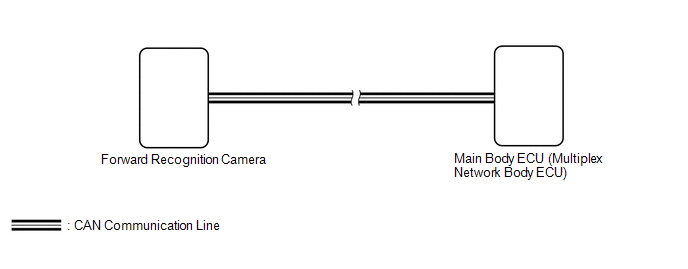
CAUTION / NOTICE / HINT
NOTICE:
- The lighting system (for Gasoline Model without Cornering Light) uses
the CAN communication system. Inspect the communication functions by
following How to Proceed with Troubleshooting. Troubleshoot the
automatic high beam system after confirming that the communication
systems are functioning properly.
Click here 
- Before replacing the main body ECU (multiplex network body ECU), refer to Registration.
Click here 
HINT:
If the forward recognition camera stores a DTC for a malfunction of any
of the following, this DTC will be stored simultaneously.
- Speed sensor
- Yaw rate sensor
- CAN communication system
PROCEDURE
|
1. | CHECK FOR DTC (HEALTH CHECK) |
(a) Connect the Techstream to the DLC3.
(b) Turn the engine switch on (IG).
(c) Turn the Techstream on.
(d) Enter the following menus: System Select / Health Check.
(e) Check for DTCs.
|
Result | Proceed to |
|
Only DTC B124B is output |
A |
| DTC B124B and other DTCs are output |
B |
| B |
 | GO TO OTHER DTC CHART |
|
A |
 | |
| 2. |
CHECK FRONT CAMERA SYSTEM |
(a)
Check if a dynamic radar cruise control system, lane departure alert
system or pre-collision system warning message is displayed on the
multi-information display.
Click here 
OK:
No dynamic radar cruise control system, lane departure alert system and pre-collision system warning messages are displayed.
| OK |
 | REPLACE MAIN BODY ECU (MULTIPLEX NETWORK BODY ECU) |
| NG |
 | GO TO FRONT CAMERA SYSTEM |
Automatic High Beam Camera (B124C)
DESCRIPTION
The main body
ECU (multiplex network body ECU) detects a high beam headlight
illumination request signal of the automatic high beam system from the
forward recognition camera.
|
DTC No. | Detection Item |
DTC Detection Condition | Trouble Area |
DTC Output from |
|
B124C | Automatic High Beam Camera |
Malfunction in forward recognition camera |
Front camera system | Main body ECU (multiplex network body ECU) |
WIRING DIAGRAM
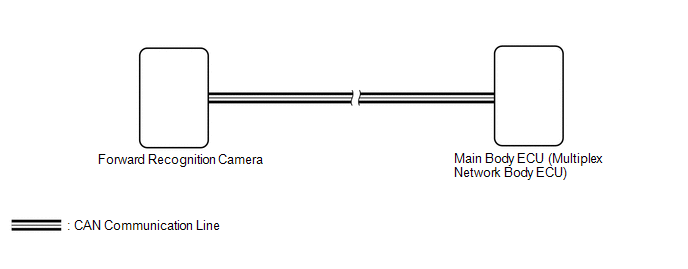
PROCEDURE
| 1. |
CHECK FRONT CAMERA SYSTEM |
(a) Check front camera system.
Click here 
| NEXT |
 | END |
Light Sensor Circuit (B1244)
DESCRIPTION
The automatic
light control sensor detects ambient light. The sensor creates an
electrical signal based on the amount of light detected, and sends the
signal to the main body ECU (multiplex network body ECU). The main body
ECU (multiplex network body ECU) turns on or off the headlights and
taillights according to the signal.
|
DTC No. | Detection Item |
DTC Detection Condition | Trouble Area |
DTC Output from |
|
B1244 | Light Sensor Circuit |
- The engine switch is on (IG).
- Either of the following conditions is met:
- Malfunction in automatic light control sensor
- Open or short in automatic light control sensor circuit
|
- Automatic light control sensor
- Harness or connector
- Main body ECU (multiplex network body ECU)
| Main body ECU (multiplex network body ECU) |
WIRING DIAGRAM
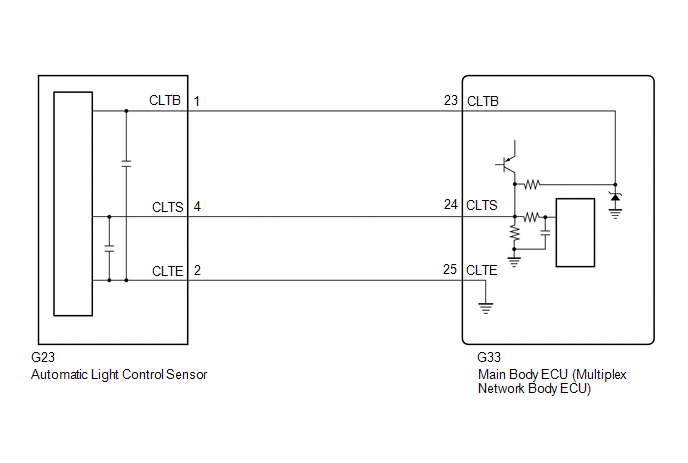
CAUTION / NOTICE / HINT
NOTICE:
Before replacing the main body ECU (multiplex network body ECU), refer to Registration.
Click here 
PROCEDURE
(a) Connect the Techstream to the DLC3.
(b) Turn the engine switch on (IG).
(c) Turn the Techstream on.
(d) Enter the following menus: Body Electrical / Main Body / Trouble Codes.
(e) Clear the DTCs.
Body Electrical > Main Body > Clear DTCs
|
NEXT |
 | |
(a) Connect the Techstream to the DLC3.
(b) Turn the engine switch on (IG).
(c) Wait 10 seconds or more.
(d) Turn the Techstream on.
(e) Enter the following menus: Body Electrical / Main Body / Trouble Codes.
(f) Check for DTCs.
Body Electrical > Main Body > Trouble Codes OK:
DTC B1244 is not output.
| OK |  |
USE SIMULATION METHOD TO CHECK |
|
NG |
 | |
| 3. |
READ VALUE USING TECHSTREAM |
(a) Connect the Techstream to the DLC3.
(b) Turn the engine switch on (IG).
(c) Turn the Techstream on.
(d) Enter the following menus: Body Electrical / Main Body / Data List.
(e)
According to the display on the Techstream, read the Data List and
check that the value of Light Sensor Illuminance changes while
performing the following:
(1) Cover the automatic light control sensor with an opaque object.
(2) Slowly move the opaque object to uncover and then cover the automatic light control sensor.
Body Electrical > Main Body > Data List
|
Tester Display | Measurement Item |
Range | Normal Condition |
Diagnostic Note |
|
Light Sensor Illuminance |
Light control sensor illuminance |
0 to 8191 lx or SensorFail |
Value is output according to ambient light level |
- |
Body Electrical > Main Body > Data List
|
Tester Display |
| Light Sensor Illuminance |
OK:
The value changes according to the amount the automatic light control sensor is covered.
| OK |
 | REPLACE MAIN BODY ECU (MULTIPLEX NETWORK BODY ECU) |
|
NG |
 | |
| 4. |
CHECK HARNESS AND CONNECTOR (AUTOMATIC LIGHT CONTROL SENSOR - MAIN BODY ECU (MULTIPLEX NETWORK BODY ECU)) |
(a) Disconnect the G23 automatic light control sensor connector.
(b) Disconnect the G33 main body ECU (multiplex network body ECU) connector.
(c) Measure the resistance according to the value(s) in the table below.
Standard Resistance:
|
Tester Connection | Condition |
Specified Condition |
|
G23-1 (CLTB) - G33-23 (CLTB) |
Always | Below 1 Ω |
|
G23-4 (CLTS) - G33-24 (CLTS) |
Always | Below 1 Ω |
|
G23-2 (CLTE) - G33-25 (CLTE) |
Always | Below 1 Ω |
|
G23-1 (CLTB) or G33-23 (CLTB) - Body ground |
Always | 10 kΩ or higher |
|
G23-4 (CLTS) or G33-24 (CLTS) - Body ground |
Always | 10 kΩ or higher |
|
G23-2 (CLTE) or G33-25 (CLTE) - Body ground |
Always | 10 kΩ or higher |
| NG |
 | REPAIR OR REPLACE HARNESS OR CONNECTOR |
|
OK |
 | |
| 5. |
INSPECT MAIN BODY ECU (MULTIPLEX NETWORK BODY ECU) |
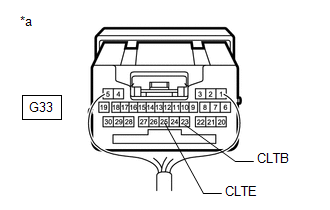
|
*a | Component with harness connected
(Main Body ECU (Multiplex Network Body ECU)) |
(a) Connect the G33 main body ECU (multiplex network body ECU) connector.
(b) Measure the voltage according to the value(s) in the table below.
Standard Voltage:
|
Tester Connection | Condition |
Specified Condition |
|
G33-23 (CLTB) - G33-25 (CLTE) |
Engine switch off | Below 1 V |
|
Engine switch on (IG) |
11 to 14 V |
| NG |
 | REPLACE MAIN BODY ECU (MULTIPLEX NETWORK BODY ECU) |
|
OK |
 | |
| 6. |
INSPECT AUTOMATIC LIGHT CONTROL SENSOR |
(a) Inspect the automatic light control sensor.
Click here

| OK |  |
REPLACE MAIN BODY ECU (MULTIPLEX NETWORK BODY ECU) |
| NG |
 | REPLACE AUTOMATIC LIGHT CONTROL SENSOR |
Customize Parameters
CUSTOMIZE PARAMETERS
CUSTOMIZE LIGHTING SYSTEM (EXT) (for Gasoline Model without Cornering Light)
NOTICE:
- When the customer requests a change in a function, first make sure that the function can be customized.
- Be sure to make a note of the current settings before customizing.
- When troubleshooting a function, first make sure that the function is set to the default setting.
HINT:
The following items can be customized.
(a) Customizing with the Techstream
(1) Connect the Techstream to the DLC3.
(2) Turn the engine switch on (IG).
(3) Turn the Techstream on.
(4) Enter the following menus: Customize Setting / Light Control or Warning.
(5) Select the setting by referring to the table below.
Light Control
|
Tester Display | Description |
Default | Setting |
ECU |
| Disp Ex ON Sen |
Changes
the ambient brightness level required to dim the lights such as the
indicator lights of the combination meter, A/C indicator light and
clock.*A | NORMAL |
000:NORMAL,001:DARK2,010:DARK1,011:LIGHT1,100:LIGHT2 |
Main Body ECU (Multiplex Network Body ECU) |
|
Disp Ex OFF Sen | Changes
the ambient brightness level required to cancel the dimming of the
lights such as the indicator lights of the combination meter, A/C
indicator light and clock.*B | NORMAL |
000:NORMAL,001:DARK2,010:DARK1,011:LIGHT1,100:LIGHT2 |
Main Body ECU (Multiplex Network Body ECU) |
|
Light Auto OFF Delay | Keeps
the headlights on for a certain period of time after turning the engine
switch off and closing all of doors with the low beam headlights on. |
30 s | 00:OFF,01:30 s,10:60 s,11:90 s |
Main Body ECU (Multiplex Network Body ECU) |
|
Sensitivity | Adjusts the sensitivity of the automatic light control system.*C |
Normal | 000:Normal,001:Dark2,010:Dark1,011:Light1,100:Light2 |
Main Body ECU (Multiplex Network Body ECU) |
|
DRL Function | Turns the DRL function on/off.* |
ON | 0:OFF,1:ON |
Main Body ECU (Multiplex Network Body ECU) |
|
Light up Clearance Lights at Door Unlock Function |
Turns on the parking lights and the taillights for 15 seconds when a door unlock operation is performed. |
ON | 0:OFF,1:ON |
Main Body ECU (Multiplex Network Body ECU) |
|
Headlight in Conjunction with Wiper |
Turns the low beam headlights on/off according to wiper operation. |
ON | 0:OFF,1:ON |
Main Body ECU (Multiplex Network Body ECU) |
|
Tail Remind Buzzer Function |
Sounds a buzzer when the driver door is opened with the light control switch in the tail or head position. |
ON | 0:OFF,1:ON |
Main Body ECU (Multiplex Network Body ECU) |
- *: for vehicles with customize setting "DRL Function"
HINT:
The sensitivity adjustment may be difficult to confirm. Check by driving the vehicle.
Warning |
Tester Display | Description |
Default | Setting |
ECU |
| Lane Change Flashing Times Adjust |
Function to change the lane change flashing times. |
3 | $00:OFF,$01:3,$02:4,$03:5,$04:6,$05:7 |
Combination Meter Assembly |
(b) Customizing with the multi-display
(1) Turn the engine switch on (IG).
(2) Enter the following menus: MENU / Setup / Vehicle / Vehicle Customization / Lights Settings.
(3) Select the setting by referring to the table below.
|
Display | Default |
Content | Setting |
Relevant ECU |
| Headlights Auto-on Sensitivity |
0 | Adjusts the sensitivity of the automatic light control system.*A |
-2, -1, 0, +1 or +2 | Main Body ECU (Multiplex Network Body ECU) |
|
Headlights Auto-off Timer |
30 sec. | Keeps
the headlights on for a certain period of time after turning the engine
switch off and closing all of doors with the low beam headlights on. |
Off, 30 sec., 60 sec. or 90 sec. | Main Body ECU (Multiplex Network Body ECU) |
|
Daytime Running Lights* |
On | Turns the DRL function on/off. |
On or Off | Main Body ECU (Multiplex Network Body ECU) |
- *: for vehicles with customize setting "Daytime Running Lights"
HINT:
The sensitivity adjustment may be difficult to confirm. Check by driving the vehicle.
- *A

Data List / Active Test
DATA LIST / ACTIVE TEST
DATA LIST
NOTICE:
In
the table below, the values listed under "Normal Condition" are
reference values. Do not depend solely on these reference values when
deciding whether a part is faulty or not.
HINT:
Using
the Techstream to read the Data List allows the values or states of
switches, sensors, actuators and other items to be read without removing
any parts. This non-intrusive inspection can be very useful because
intermittent conditions or signals may be discovered before parts or
wiring is disturbed. Reading the Data List information early in
troubleshooting is one way to save diagnostic time.
(a) Connect the Techstream to the DLC3.
(b) Turn the engine switch on (IG).
(c) Turn the Techstream on.
(d) Enter the following menus:
(1) for Main Body: Body Electrical / Main Body / Data List.
(2) for Steering Angle Sensor: Chassis / Steering Angle Sensor / Data List.
(3) for Combination Meter: Body Electrical / Combination Meter / Data List.
(4) for Front Recognition Camera: Chassis / Front Recognition Camera / Data List.
(e) Read the Data List according to the display on the Techstream.
Body Electrical > Main Body > Data List
|
Tester Display | Measurement Item |
Range | Normal Condition |
Diagnostic Note |
|
Auto High Beam Main Switch |
Auto high beam switch signal |
OFF or ON | OFF: Auto high beam switch not pressed
ON: Auto high beam switch pressed |
- |
| Head Light SW (Head) |
Light control switch head position signal |
OFF or ON | OFF: Light control switch not in head position
ON: Light control switch in head position |
- |
| Insolation Amount of Solar Sensor RH |
Solar sensor RH condition |
0 to 51100 or SensorFail |
Condition can be displayed |
- |
| Insolation Amount of Solar Sensor LH |
Solar sensor LH condition |
0 to 51100 or SensorFail |
Condition can be displayed |
- |
| Light Sensor Illuminance |
Light control sensor illuminance |
0 to 8191 lx or SensorFail |
Value is output according to ambient light level |
- |
| Light Sensor Connection Status |
Light control sensor connection status |
OFF or ON | OFF: Automatic light control sensor has not been connected
ON: Automatic light control sensor connected or has been connected |
- |
| Headlight Lighting Function |
ECU which controls the lighting system |
Main Body or Lighting Sys ECU |
Main Body: Lighting system controlled by main body ECU (multiplex network body ECU)
Lighting Sys ECU: Lighting system is controlled by headlight ECU sub-assembly |
- |
| Sensitivity |
Sensitivity of the automatic light control system |
Light2, Light1, Normal, Dark1 or Dark2 |
Customize setting displayed |
- |
| DRL Function |
Setting of the DRL function on/off |
OFF or ON | Customize setting displayed |
for vehicles with customize setting "DRL Function" |
|
Headlight in Conjunction with Wiper |
Wiper-linked low beam headlight control |
OFF or ON | Customize setting displayed |
- |
| Disp Ex ON Sen |
Ambient brightness level required to dim display lights (combination meter, navigation display, etc.) |
Light2, Light1, Normal, Dark1 or Dark2 |
Customize setting displayed |
- |
| Disp Ex OFF Sen |
Ambient brightness level required to cancel dimming display lights (combination meter, navigation display, etc.) |
Light2, Light1, Normal, Dark1 or Dark2 |
Customize setting displayed |
- |
| Light Auto OFF Delay |
Light auto OFF delay |
Off, 30 s, 60 s or 90 s |
Customize setting displayed |
- |
| Auto H Beam STS0 |
Automatic high beam sensor current state |
Undetec, CAM NA, No sens, Hlight, Taillgt, Speed, Daytime, Village, Malfunc, Delay, Aim Lmt, SAE Mod, Undefin or LIN Err |
Condition can be displayed* |
If the value of this item is not as specified, the automatic high beam sensor system may be malfunctioning. |
|
Auto H Beam STS1 | Automatic high beam sensor state past 1 |
Undetec, CAM NA, No sens, Hlight, Taillgt, Speed, Daytime, Village, Malfunc, Delay, Aim Lmt, SAE Mod, Undefin or LIN Err |
Condition can be displayed* |
Although this item is displayed on the Techstream, it is not applicable to this vehicle. |
|
Auto H Beam STS2 | Automatic high beam sensor state past 2 |
Undetec, CAM NA, No sens, Hlight, Taillgt, Speed, Daytime, Village, Malfunc, Delay, Aim Lmt, SAE Mod, Undefin or LIN Err |
Condition can be displayed* |
Although this item is displayed on the Techstream, it is not applicable to this vehicle. |
|
Auto H Beam STS3 | Automatic high beam sensor state past 3 |
Undetec, CAM NA, No sens, Hlight, Taillgt, Speed, Daytime, Village, Malfunc, Delay, Aim Lmt, SAE Mod, Undefin or LIN Err |
Condition can be displayed* |
Although this item is displayed on the Techstream, it is not applicable to this vehicle. |
|
Auto H Beam STS4 | Automatic high beam sensor state past 4 |
Undetec, CAM NA, No sens, Hlight, Taillgt, Speed, Daytime, Village, Malfunc, Delay, Aim Lmt, SAE Mod, Undefin or LIN Err |
Condition can be displayed* |
Although this item is displayed on the Techstream, it is not applicable to this vehicle. |
|
Auto H Beam STS5 | Automatic high beam sensor state past 5 |
Undetec, CAM NA, No sens, Hlight, Taillgt, Speed, Daytime, Village, Malfunc, Delay, Aim Lmt, SAE Mod, Undefin or LIN Err |
Condition can be displayed* |
Although this item is displayed on the Techstream, it is not applicable to this vehicle. |
|
Auto H Beam STS6 | Automatic high beam sensor state past 6 |
Undetec, CAM NA, No sens, Hlight, Taillgt, Speed, Daytime, Village, Malfunc, Delay, Aim Lmt, SAE Mod, Undefin or LIN Err |
Condition can be displayed* |
Although this item is displayed on the Techstream, it is not applicable to this vehicle. |
|
Auto H Beam STS7 | Automatic high beam sensor state past 7 |
Undetec, CAM NA, No sens, Hlight, Taillgt, Speed, Daytime, Village, Malfunc, Delay, Aim Lmt, SAE Mod, Undefin or LIN Err |
Condition can be displayed* |
Although this item is displayed on the Techstream, it is not applicable to this vehicle. |
|
Light up Clearance Lights at Door Unlock Function |
Setting of the welcome light illumination control customize setting |
OFF or ON | Customize setting displayed |
- |
| Tail Remind Buzzer Function |
Setting of the tail remind buzzer function on/off |
OFF or ON | Customize setting displayed |
- |
| The Number of DTC |
Number of trouble codes |
0 to 255 | Number of stored DTCs displayed |
- |
HINT:
*: The details of each value of the Range are as follows:
|
Display Value | Condition |
Control Condition | Diagnostic Note |
|
Undetec | Automatic high beam sensor being initialized |
Control suspended (low beam headlights illuminated) |
- |
| CAM NA |
Automatic high beam sensor temporarily disabled due to high temperature, unclear image (due to dirt, fog, etc.), etc. |
Control suspended (low beam headlights illuminated) |
- |
| No sens |
No lights detected | High beam headlights illuminated |
Only when vehicle speed within operation speed range |
|
Hlight | Headlights of oncoming vehicle, etc. detected |
Low beam headlights illuminated |
Only when vehicle speed within operation speed range |
|
Taillgt | Taillights preceding vehicle, etc. detected |
Low beam headlights illuminated |
Only when vehicle speed within operation speed range |
|
Speed | No lights detected and vehicle speed below operation speed |
Low beam headlights illuminated |
- |
| Daytime |
Bright light detected | Low beam headlights illuminated |
- |
| Village |
Streetlights, etc. detected |
Low beam headlights illuminated |
Only when vehicle speed within operation speed range |
|
Delay | Changing between low beams and high beams |
Changing between low beams and high beams |
Only when vehicle speed within operation speed range |
|
SAE Mod | Not applicable |
- | - |
|
Malfunc |
| Aim Lmt |
|
Undefin |
| LIN Err |
Chassis > Steering Angle Sensor > Data List
|
Tester Display | Measurement Item |
Range | Normal Condition |
Diagnostic Note |
|
Light OFF Switch | Light control switch DRL OFF position signal |
OFF or ON | OFF: Light control switch not in DRL OFF position
ON: Light control switch in DRL OFF position |
w/ DRL OFF Switch |
|
Auto Light Switch | Light control switch AUTO position signal |
OFF or ON | OFF: Light control switch not in AUTO position
ON: Light control switch in AUTO position |
- |
| Head Light Switch (Tail) |
Light control switch tail position signal |
OFF or ON | OFF: Light control switch in neither tail nor head position
ON: Light control switch in tail or head position |
- |
| Head Light Switch (Head) |
Light control switch head position signal |
OFF or ON | OFF: Light control switch not in head position
ON: Light control switch in head position |
- |
| High Beam Main Switch |
Dimmer switch high position signal |
OFF or ON | OFF: Dimmer switch not in high position
ON: Dimmer switch in high position |
- |
| Passing Light Switch |
Dimmer switch high flash position (pass) signal |
OFF or ON | OFF: Dimmer switch not in high flash position
ON: Dimmer switch in high flash position |
- |
| Auto High Beam Main Switch |
Auto high beam switch signal |
OFF or ON | OFF: Auto high beam switch off
ON: Auto high beam switch on |
Although the item is displayed on the Techstream, it is not applicable to the vehicle. |
|
Turn Signal Switch (Right) |
Turn signal switch (right turn position) signal |
OFF or ON | OFF: Turn signal switch not in right turn position
ON: Turn signal switch in right turn position |
- |
| Turn Signal Switch (Left) |
Turn signal switch (left turn position) signal |
OFF or ON | OFF: Turn signal switch not in left turn position
ON: Turn signal switch in left turn position |
- |
| Cornering Light/Front Side Illuminate Light Switch |
Turn signal switch (full turn) signal |
OFF or ON | OFF: Turn signal switch not in left or right turn position
ON: Turn signal switch in left or right full turn position |
- |
| Front Fog Light Switch |
Front fog light switch signal |
OFF or ON | OFF: Front fog light switch off
ON: Front fog light switch on |
Although the item is displayed on the Techstream, it is not applicable to the vehicle. |
|
Rear Fog Light/Bad Weather Switch |
Rear fog light switch signal |
OFF or ON | OFF: Rear fog light switch off
ON: Rear fog light switch on |
Although the item is displayed on the Techstream, it is not applicable to the vehicle. |
|
Automatic Light Equipped Info |
Automatic light control system specification information |
Unknown, With or Without |
Unknown: Specification not stored With: Automatic light control system equipped
Without: Automatic light control system not equipped |
- |
| Bad Weather Mode Equipped Info |
Bad weather specification information |
Unknown, Without or With |
Unknown: Specification not stored Without: Bad weather specification not equipped
With: Bad weather specification equipped |
Although the item is displayed on the Techstream, it is not applicable to the vehicle. |
|
The Number of DTCs | Number of trouble codes |
0 to 255 | Number of stored DTCs displayed |
- |
Body Electrical > Combination Meter > Data List
|
Tester Display | Measurement Item |
Range | Normal Condition |
Diagnostic Note |
|
Turn Signal Switch (Left) |
Turn signal switch (left) signal |
OFF or ON | OFF: Turn signal switch not in left turn position
ON: Turn signal switch in left turn position |
Although this item is displayed on the Techstream, it is not applicable to this vehicle. |
|
Turn Signal Switch (Right) |
Turn signal switch (right) signal |
OFF or ON | OFF: Turn signal switch not in right turn position
ON: Turn signal switch in right turn position |
Although this item is displayed on the Techstream, it is not applicable to this vehicle. |
|
Turn Switch Signal (Full Turn) |
Turn signal switch (full turn) signal |
OFF or ON | OFF: Turn signal switch not in left or right turn position
ON: Turn signal switch in left or right turn position |
Although this item is displayed on the Techstream, it is not applicable to this vehicle. |
|
Hazard Flasher Switch | Hazard warning signal switch signal |
OFF or ON | OFF: Hazard warning signal switch off
ON: Hazard warning signal switch on |
- |
| Lane Change Flashing Times Adjust |
Condition of the lane change flashing times |
OFF, 3, 4, 5, 6 or 7 | Customize setting displayed |
- |
Chassis > Front Recognition Camera > Data List
|
Tester Display | Measurement Item |
Range | Normal Condition |
Diagnostic Note |
|
High Temperature Status1 |
High temperature malfunction status |
OFF or ON | OFF: Forward recognition camera high temperature malfunction does not exist
ON: Forward recognition camera high temperature malfunction exists |
- |
ACTIVE TEST
HINT:
Using
the Techstream to perform Active Tests allows relays, VSVs, actuators
and other items to be operated without removing any parts. This
non-intrusive functional inspection can be very useful because
intermittent operation may be discovered before parts or wiring is
disturbed. Performing Active Tests early in troubleshooting is one way
to save diagnostic time. Data List information can be displayed while
performing Active Tests.
(a) Connect the Techstream to the DLC3.
(b) Turn the engine switch on (IG).
(c) Turn the Techstream on.
(d) Enter the following menus:
(1) for Main Body: Body Electrical / Main Body / Active Test.
(2) for Combination Meter: Body Electrical / Combination Meter / Active Test.
(e) Perform the Active Test according to the display on the Techstream.
Body Electrical > Main Body > Active Test
|
Tester Display | Measurement Item |
Control Range | Diagnostic Note |
|
Daytime Running Light | Daytime running lights |
OFF or ON | - |
|
Taillight Relay | Taillight relay |
OFF or ON | - |
|
Headlight Relay | Low beam headlights |
OFF or ON | - |
|
Head Light Hi | High beam headlights |
OFF or ON | - |
|
Rear Fog Light Relay | Rear fog lights |
OFF or ON | Although this item is displayed on the Techstream, it is not applicable to this vehicle. |
|
Automatic High Beam Switch Light |
Auto high beam switch indicator light |
OFF or ON | - |
Body Electrical > Combination Meter > Active Test
|
Tester Display | Measurement Item |
Control Range | Diagnostic Note |
|
Multi Display All (White) |
Multi-information display (White display) |
OFF or ON | - |
Daytime Running Light Circuit
DESCRIPTION
The main body ECU (multiplex network body ECU) controls the daytime running lights.
WIRING DIAGRAM
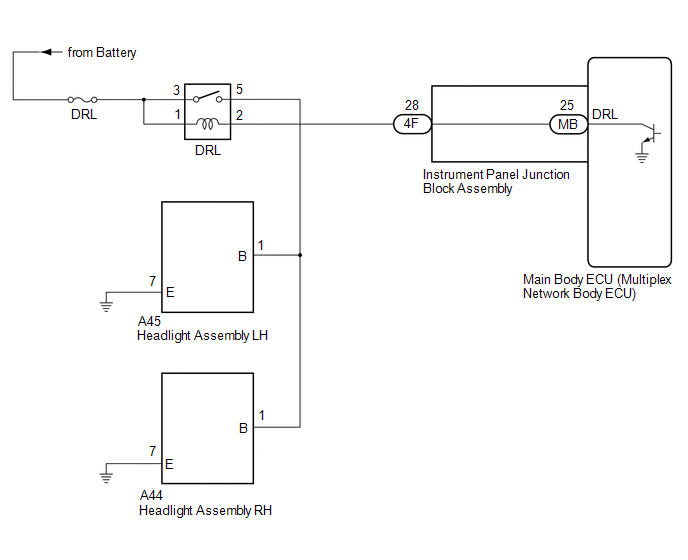
CAUTION / NOTICE / HINT
NOTICE:
- Inspect the fuses for circuits related to this system before performing the following procedure.
- Before replacing the main body ECU (multiplex network body ECU), refer to Registration.
Click here 
PROCEDURE
|
1. | CHECK OPERATION (LOW BEAM HEADLIGHTS) |
(a) Check the operation of the low beam headlights.
OK:
The low beam headlights operate normally.
| NG |
 | GO TO PROBLEM SYMPTOMS TABLE |
|
OK |
 | |
| 2. |
PERFORM ACTIVE TEST USING TECHSTREAM |
(a) Connect the Techstream to the DLC3.
(b) Turn the engine switch on (IG).
(c) Turn the Techstream on.
(d) Enter the following menus: Body Electrical / Main Body / Active Test.
(e) Perform the Active Test according to the display on the Techstream.
Body Electrical > Main Body > Active Test
|
Tester Display | Measurement Item |
Control Range | Diagnostic Note |
|
Daytime Running Light | Daytime running lights |
OFF or ON | - |
Body Electrical > Main Body > Active Test
|
Tester Display |
| Daytime Running Light |
OK:
Daytime running lights illuminate.
| OK |
 | PROCEED TO NEXT SUSPECTED AREA SHOWN IN PROBLEM SYMPTOMS TABLE |
|
NG |
 | |
(a) Inspect the DRL relay.
Click here 
| NG |
 | REPLACE DRL RELAY |
|
OK |
 | |
| 4. |
CHECK HARNESS AND CONNECTOR (POWER SOURCE - DRL RELAY) |
(a) Measure the voltage according to the value(s) in the table below.
Standard Voltage:
|
Tester Connection | Condition |
Specified Condition |
|
1 (DRL relay) - Body ground |
Always | 11 to 14 V |
|
3 (DRL relay) - Body ground |
Always | 11 to 14 V |
| NG |
 | REPAIR OR REPLACE HARNESS OR CONNECTOR |
|
OK |
 | |
| 5. |
CHECK HARNESS AND CONNECTOR (DRL RELAY - HEADLIGHT ASSEMBLY) |
(a) Disconnect the A45 headlight assembly LH connector.
(b) Disconnect the A44 headlight assembly RH connector.
(c) Measure the resistance according to the value(s) in the table below.
Standard Resistance:
|
Tester Connection | Condition |
Specified Condition |
|
5 (DRL relay) - A45-1 (B) |
Always | Below 1 Ω |
|
5 (DRL relay) - A44-1 (B) |
Always | Below 1 Ω |
|
5 (DRL relay) or A45-1 (B) - Body ground |
Always | 10 kΩ or higher |
|
5 (DRL relay) or A44-1 (B) - Body ground |
Always | 10 kΩ or higher |
| NG |
 | REPAIR OR REPLACE HARNESS OR CONNECTOR |
|
OK |
 | |
| 6. |
CHECK HARNESS AND CONNECTOR (DRL RELAY - INSTRUMENT PANEL JUNCTION BLOCK ASSEMBLY) |
(a) Disconnect the 4F instrument panel junction block assembly connector.
(b) Measure the resistance according to the value(s) in the table below.
Standard Resistance:
|
Tester Connection | Condition |
Specified Condition |
|
2 (DRL relay) - 4F-28 |
Always | Below 1 Ω |
|
2 (DRL relay) or 4F-28 - Body ground |
Always | 10 kΩ or higher |
| NG |
 | REPAIR OR REPLACE HARNESS OR CONNECTOR |
|
OK |
 | |
| 7. |
INSPECT INSTRUMENT PANEL JUNCTION BLOCK ASSEMBLY |
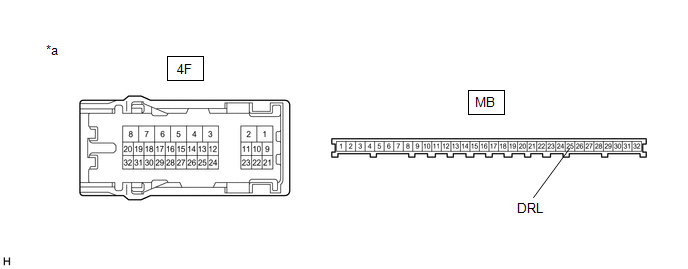
|
*a | Component without harness connected
(Instrument Panel Junction Block Assembly) |
- | - |
(a) Remove the main body ECU (multiplex network body ECU) from the instrument panel junction block assembly.
Click here 
(b) Measure the resistance according to the value(s) in the table below.
Standard Resistance:
|
Tester Connection | Condition |
Specified Condition |
|
4F-28 - MB-25 (DRL) | Always |
Below 1 Ω |
| OK |
 | REPLACE MAIN BODY ECU (MULTIPLEX NETWORK BODY ECU) |
| NG |
 | REPLACE INSTRUMENT PANEL JUNCTION BLOCK ASSEMBLY |
Diagnostic Trouble Code Chart
DIAGNOSTIC TROUBLE CODE CHART
Lighting System (for Gasoline Model without Cornering Light) |
DTC No. | Detection Item |
DTC Output from | Link |
|
B1244 | Light Sensor Circuit |
Main body ECU (multiplex network body ECU) |
 |
|
B124B | Automatic High Beam System |
Main body ECU (multiplex network body ECU) |
 |
|
B124C | Automatic High Beam Camera |
Main body ECU (multiplex network body ECU) |
 |
|
U0100 | Lost Communication With ECM/PCM "A" |
Main body ECU (multiplex network body ECU) |
 |
|
U0101 | Lost Communication with TCM |
Main body ECU (multiplex network body ECU) |
 |
|
U0120 | Lost Communication With Starter / Generator Control Module |
Main body ECU (multiplex network body ECU) |
 |
|
U0126 | Lost Communication with Steering Angle Sensor Module |
Main body ECU (multiplex network body ECU) |
 |
|
U0129 | Lost Communication with Brake System Control Module |
Main body ECU (multiplex network body ECU) |
 |
|
U0151 | Lost Communication with Restraints Control Module |
Main body ECU (multiplex network body ECU) |
 |
|
U0155 | Lost Communication with Instrument Panel Cluster (IPC) Control Module |
Main body ECU (multiplex network body ECU) |
 |
|
U0163 | Lost Communication with Navigation Control Module |
Main body ECU (multiplex network body ECU) |
 |
|
U0164 | Lost Communication with HVAC Control Module |
Main body ECU (multiplex network body ECU) |
 |
|
U023A | Lost Communication With Image Processing Module "A" |
Main body ECU (multiplex network body ECU) |
 |
|
U0327 | Software Incompatibility with Vehicle Security Control Module |
Main body ECU (multiplex network body ECU) |
 |
|
U1106 | Lost Communication with Electric Parking Brake Module |
Main body ECU (multiplex network body ECU) |
 |
|
U1117 | Lost Communication with Accessory Gateway |
Main body ECU (multiplex network body ECU) |
 |
Dtc Check / Clear
DTC CHECK / CLEAR
CHECK FOR DTC
(a) Connect the Techstream to the DLC3.
(b) Turn the engine switch on (IG).
(c) Turn the Techstream on.
(d) Enter the following menus: Body Electrical / Main Body / Trouble Codes.
Body Electrical > Main Body > Trouble Codes
(e) Check for DTCs.
CLEAR DTC
(a) Connect the Techstream to the DLC3.
(b) Turn the engine switch on (IG).
(c) Turn the Techstream on.
(d) Enter the following menus: Body Electrical / Main Body / Trouble Codes.
Body Electrical > Main Body > Clear DTCs
(e) Clear the DTCs.
Hazard Warning Switch Circuit
DESCRIPTION
The combination
meter assembly receives the hazard warning signal switch (radio and
display receiver assembly) on signal and controls the operation of the
hazard warning lights.
WIRING DIAGRAM
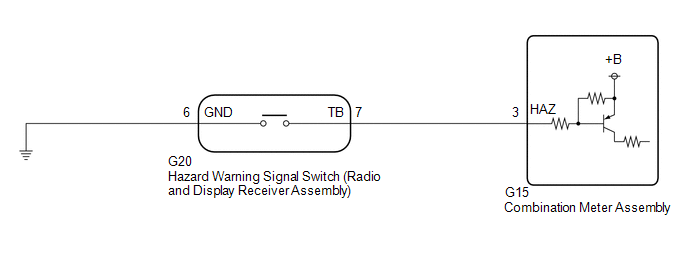
CAUTION / NOTICE / HINT
NOTICE:
When
replacing the combination meter assembly, always replace it with a new
one. If a combination meter assembly which was installed to another
vehicle is used, the information stored in it will not match the
information from the vehicle and a DTC may be stored.
PROCEDURE
| 1. |
READ VALUE USING TECHSTREAM |
(a) Connect the Techstream to the DLC3.
(b) Turn the engine switch on (IG).
(c) Turn the Techstream on.
(d) Enter the following menus: Body Electrical / Combination Meter / Data List.
(e) Read the Data List according to the display on the Techstream.
Body Electrical > Combination Meter > Data List
|
Tester Display | Measurement Item |
Range | Normal Condition |
Diagnostic Note |
|
Hazard Flasher Switch | Hazard warning signal switch signal |
OFF or ON | OFF: Hazard warning signal switch off
ON: Hazard warning signal switch on |
- |
Body Electrical > Combination Meter > Data List
|
Tester Display |
| Hazard Flasher Switch |
OK:
Normal conditions listed above are displayed.
| OK |
 | PROCEED TO NEXT SUSPECTED AREA SHOWN IN PROBLEM SYMPTOMS TABLE |
|
NG |
 | |
| 2. |
INSPECT HAZARD WARNING SIGNAL SWITCH (RADIO AND DISPLAY RECEIVER ASSEMBLY) |
(a) Remove the hazard warning signal switch (radio and display receiver assembly).
Click here 
(b) Inspect the hazard warning signal switch (radio and display receiver assembly).
Click here 
| NG |
 | REPLACE HAZARD WARNING SIGNAL SWITCH (RADIO AND DISPLAY RECEIVER ASSEMBLY) |
|
OK |
 | |
| 3. |
CHECK
HARNESS AND CONNECTOR (HAZARD WARNING SIGNAL SWITCH (RADIO AND DISPLAY
RECEIVER ASSEMBLY) - COMBINATION METER ASSEMBLY AND BODY GROUND) |
(a) Disconnect the G15 combination meter assembly connector.
(b) Measure the resistance according to the value(s) in the table below.
Standard Resistance:
|
Tester Connection | Condition |
Specified Condition |
|
G20-7 (TB) - G15-3 (HAZ) |
Always | Below 1 Ω |
|
G20-7 (TB) or G15-3 (HAZ) - Body ground |
Always | 10 kΩ or higher |
|
G20-6 (GND) - Body ground |
Always | Below 1 Ω |
| OK |
 | REPLACE COMBINATION METER ASSEMBLY |
| NG |
 | REPAIR OR REPLACE HARNESS OR CONNECTOR |
Headlight Dimmer Switch Circuit
DESCRIPTION
The steering sensor receives the following switch information:
- Light control switch in DRL OFF*, tail, head or AUTO position
- Dimmer switch in high, low or high flash (pass) position
WIRING DIAGRAM
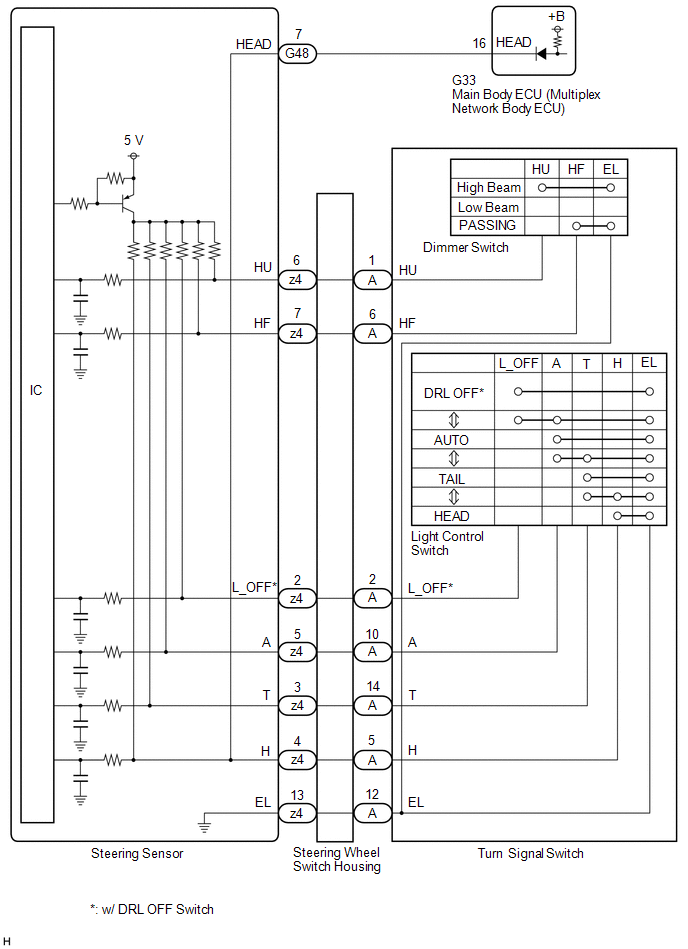
CAUTION / NOTICE / HINT
NOTICE:
Before replacing the main body ECU (multiplex network body ECU), refer to Registration.
Click here 
PROCEDURE
| 1. |
READ VALUE USING TECHSTREAM |
(a) Connect the Techstream to the DLC3.
(b) Turn the engine switch on (IG).
(c) Turn the Techstream on.
(d) Enter the following menus: Chassis / Steering Angle Sensor / Data List.
(e) Read the Data List according to the display on the Techstream.
Chassis > Steering Angle Sensor > Data List
|
Tester Display | Measurement Item |
Range | Normal Condition |
Diagnostic Note |
|
Light OFF Switch | Light control switch DRL OFF position signal |
OFF or ON | OFF: Light control switch not in DRL OFF position
ON: Light control switch in DRL OFF position |
w/ DRL OFF Switch |
|
Auto Light Switch | Light control switch AUTO position signal |
OFF or ON | OFF: Light control switch not in AUTO position
ON: Light control switch in AUTO position |
- |
| Head Light Switch (Tail) |
Light control switch tail position signal |
OFF or ON | OFF: Light control switch in neither tail nor head position
ON: Light control switch in tail or head position |
- |
| Head Light Switch (Head) |
Light control switch head position signal |
OFF or ON | OFF: Light control switch not in head position
ON: Light control switch in head position |
- |
| High Beam Main Switch |
Dimmer switch high position signal |
OFF or ON | OFF: Dimmer switch not in high position
ON: Dimmer switch in high position |
- |
| Passing Light Switch |
Dimmer switch high flash position (pass) signal |
OFF or ON | OFF: Dimmer switch not in high flash position
ON: Dimmer switch in high flash position |
- |
Chassis > Steering Angle Sensor > Data List
|
Tester Display |
| Light OFF Switch |
|
Auto Light Switch |
|
Head Light Switch (Tail) |
|
Head Light Switch (Head) |
|
High Beam Main Switch |
|
Passing Light Switch |
OK:
Normal conditions listed above are displayed.
| NG |
 | GO TO STEP 5 |
|
OK |
 | |
| 2. |
READ VALUE USING TECHSTREAM |
(a) Connect the Techstream to the DLC3.
(b) Turn the engine switch on (IG).
(c) Turn the Techstream on.
(d) Enter the following menus: Body Electrical / Main Body / Data List.
(e) Read the Data List according to the display on the Techstream.
Body Electrical > Main Body > Data List
|
Tester Display | Measurement Item |
Range | Normal Condition |
Diagnostic Note |
|
Head Light SW (Head) | Light control switch head position signal |
OFF or ON | OFF: Light control switch not in head position
ON: Light control switch in head position |
- |
Body Electrical > Main Body > Data List
|
Tester Display |
| Head Light SW (Head) |
OK:
Normal conditions listed above are displayed.
| OK |
 | PROCEED TO NEXT SUSPECTED AREA SHOWN IN PROBLEM SYMPTOMS TABLE |
|
NG |
 | |
| 3. |
INSPECT STEERING SENSOR |
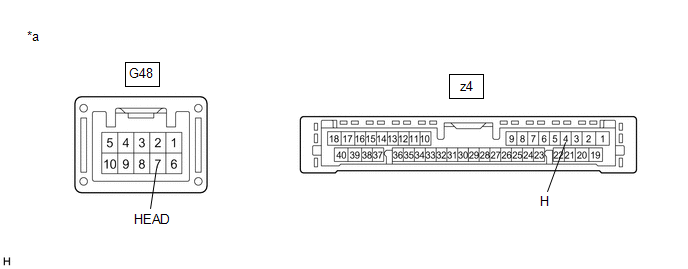
|
*a | Component without harness connected
(Steering Sensor) | - |
- |
(a) Remove the steering sensor.
Click here 
(b) Measure the resistance according to the value(s) in the table below.
Standard Resistance:
|
Tester Connection | Condition |
Specified Condition |
|
G48-7 (HEAD) - z4-4 (H) |
Always | Below 1 Ω |
| NG |
 | REPLACE STEERING SENSOR |
|
OK |
 | |
| 4. |
CHECK HARNESS AND CONNECTOR (STEERING SENSOR - MAIN BODY ECU (MULTIPLEX NETWORK BODY ECU)) |
(a) Disconnect the G33 main body ECU (multiplex network body ECU) connector.
(b) Measure the resistance according to the value(s) in the table below.
Standard Resistance:
|
Tester Connection | Condition |
Specified Condition |
|
G48-7 (HEAD) - G33-16 (HEAD) |
Always | Below 1 Ω |
|
G48-7 (HEAD) or G33-16 (HEAD) - Body ground |
Always | 10 kΩ or higher |
| OK |
 | REPLACE MAIN BODY ECU (MULTIPLEX NETWORK BODY ECU) |
| NG |
 | REPAIR OR REPLACE HARNESS OR CONNECTOR |
| 5. |
INSPECT TURN SIGNAL SWITCH |
(a) Remove the turn signal switch.
Click here 
(b) Inspect the turn signal switch.
Click here 
| NG |
 | REPLACE TURN SIGNAL SWITCH |
|
OK |
 | |
| 6. |
INSPECT STEERING WHEEL SWITCH HOUSING |
(a) Remove the steering wheel switch housing.
Click here

(b) Inspect the steering wheel switch housing.
Click here 
| OK |
 | REPLACE STEERING SENSOR |
| NG |
 | REPLACE STEERING WHEEL SWITCH HOUSING |
High Beam Headlight Circuit
DESCRIPTION
The main body ECU (multiplex network body ECU) controls the high beam headlights.
WIRING DIAGRAM
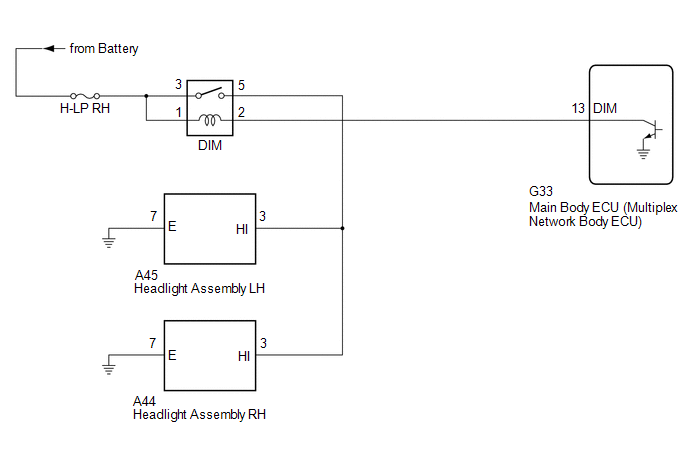
CAUTION / NOTICE / HINT
NOTICE:
- Inspect the fuses for circuits related to this system before performing the following procedure.
- Check the operation of the low beam headlights. If the low beam
headlights do not operate normally, refer to Problem Symptoms Table.
Click here 
- Before replacing the main body ECU (multiplex network body ECU), refer to Registration.
Click here 
PROCEDURE
|
1. | PERFORM ACTIVE TEST USING TECHSTREAM |
(a) Connect the Techstream to the DLC3.
(b) Turn the engine switch on (IG).
(c) Turn the Techstream on.
(d) Enter the following menus: Body Electrical / Main Body / Active Test.
(e) Perform the Active Test according to the display on the Techstream.
Body Electrical > Main Body > Active Test
|
Tester Display | Measurement Item |
Control Range | Diagnostic Note |
|
Head Light Hi | High beam headlights |
OFF or ON | - |
Body Electrical > Main Body > Active Test
|
Tester Display |
| Head Light Hi |
OK:
High beam headlights illuminate.
| OK |
 | PROCEED TO NEXT SUSPECTED AREA SHOWN IN PROBLEM SYMPTOMS TABLE |
|
NG |
 | |
(a) Inspect the DIM relay.
Click here 
| NG |
 | REPLACE DIM RELAY |
|
OK |
 | |
| 3. |
CHECK HARNESS AND CONNECTOR (POWER SOURCE - DIM RELAY) |
(a) Measure the voltage according to the value(s) in the table below.
Standard Voltage:
|
Tester Connection | Condition |
Specified Condition |
|
1 (DIM relay) - Body ground |
Always | 11 to 14 V |
|
3 (DIM relay) - Body ground |
Always | 11 to 14 V |
| NG |
 | REPAIR OR REPLACE HARNESS OR CONNECTOR |
|
OK |
 | |
| 4. |
CHECK HARNESS AND CONNECTOR (DIM RELAY - MAIN BODY ECU (MULTIPLEX NETWORK BODY ECU)) |
(a) Disconnect the G33 main body ECU (multiplex network body ECU) connector.
(b) Measure the resistance according to the value(s) in the table below.
Standard Resistance:
|
Tester Connection | Condition |
Specified Condition |
|
2 (DIM relay) - G33-13 (DIM) |
Always | Below 1 Ω |
|
2 (DIM relay) or G33-13 (DIM) - Body ground |
Always | 10 kΩ or higher |
| OK |
 | REPLACE MAIN BODY ECU (MULTIPLEX NETWORK BODY ECU) |
| NG |
 | REPAIR OR REPLACE HARNESS OR CONNECTOR |
How To Proceed With Troubleshooting
CAUTION / NOTICE / HINT
HINT:
- Use the following procedure to troubleshoot the lighting system (for Gasoline Model without Cornering Light).
- *: Use the Techstream.
PROCEDURE
|
1. | VEHICLE BROUGHT TO WORKSHOP |
|
NEXT |
 | |
| 2. |
CUSTOMER PROBLEM ANALYSIS |
HINT:
- In troubleshooting, confirm that the problem symptoms have been
accurately identified. Preconceptions should be discarded in order to
make an accurate judgment. To clearly understand what the problem
symptoms are, it is extremely important to ask the customer about the
problem and the conditions at the time the malfunction occurred.
- Gather as much information as possible for reference. Past problems that seem unrelated may also help in some cases.
- The following 5 items are important points for problem analysis:
|
What |
Vehicle model, system name |
|
When |
Date, time, occurrence frequency |
|
Where |
Road conditions |
|
Under what conditions? |
Driving conditions, weather conditions |
|
How did it happen? |
Problem symptoms |
|
NEXT |
 | |
(a) Measure the battery voltage.
Standard Voltage:
11 to 14 V
If the voltage is below 11 V, recharge or replace the battery before proceeding to the next step.
(b) Check the fuses and relays.
(c)
Check the connector connections and terminals to make sure that there
are no abnormalities such as loose connections, deformation, etc.
|
NEXT |
 | |
| 4. |
CHECK COMMUNICATION FUNCTION OF CAN COMMUNICATION SYSTEM* |
(a) Using the Techstream, check for CAN communication system DTCs.
Click here

|
Result | Proceed to |
|
CAN DTCs are not output |
A |
| CAN DTCs are output |
B |
| B |
 | GO TO CAN COMMUNICATION SYSTEM |
|
A |
 | |
(a) Check for DTCs.
Body Electrical > Main Body > Trouble Codes
|
Result | Proceed to |
|
DTCs are not output | A |
|
DTCs are output | B |
| B |
 | GO TO DIAGNOSTIC TROUBLE CODE CHART |
|
A |
 | |
| 6. |
PROBLEM SYMPTOMS TABLE |
(a) Refer to Problem Symptoms Table.
Click here 
|
Result | Proceed to |
|
Fault is not listed in Problem Symptoms Table |
A |
| Fault is listed in Problem Symptoms Table |
B |
| B |
 | GO TO PROBLEM SYMPTOMS TABLE |
|
A |
 | |
| 7. |
OVERALL ANALYSIS AND TROUBLESHOOTING* |
(a) Operation Check.
Click here 
(b) Terminals of ECU.
Click here 
(c) Data List / Active Test.
Click here

(d) On-vehicle Inspection.
(e) Inspection.
|
NEXT |
 | |
| 8. |
ADJUST, REPAIR OR REPLACE |
|
NEXT |
 | |
| NEXT |
 | END |
LO-beam Headlight does not Illuminate
DESCRIPTION
The main body ECU (multiplex network body ECU) controls the low beam headlights.
WIRING DIAGRAM
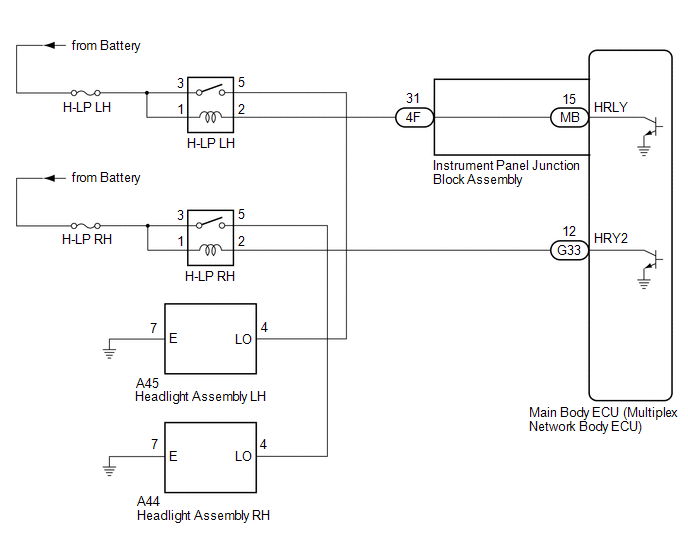
CAUTION / NOTICE / HINT
NOTICE:
- Inspect the fuses for circuits related to this system before performing the following procedure.
- Before replacing the main body ECU (multiplex network body ECU), refer to Registration.
Click here 
PROCEDURE
|
1. | PERFORM ACTIVE TEST USING TECHSTREAM |
(a) Connect the Techstream to the DLC3.
(b) Turn the engine switch on (IG).
(c) Turn the Techstream on.
(d) Enter the following menus: Body Electrical / Main Body / Active Test.
(e) Perform the Active Test according to the display on the Techstream.
Body Electrical > Main Body > Active Test
|
Tester Display | Measurement Item |
Control Range | Diagnostic Note |
|
Headlight Relay | Low beam headlights |
OFF or ON | - |
Body Electrical > Main Body > Active Test
|
Tester Display |
| Headlight Relay |
OK:
Low beam headlights illuminate.
|
Result | Proceed to |
|
OK | A |
|
NG (for LH Side) | B |
|
NG (for RH Side) | C |
| A |
 | PROCEED TO NEXT SUSPECTED AREA SHOWN IN PROBLEM SYMPTOMS TABLE |
| C |
 | GO TO STEP 9 |
|
B |
 | |
| 2. |
INSPECT HEADLIGHT ASSEMBLY LH (LO TERMINAL VOLTAGE) |
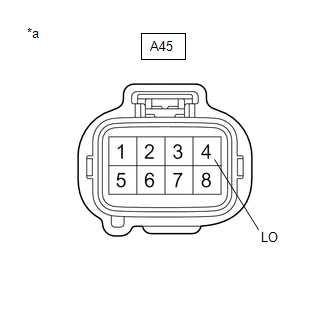
|
*a | Front view of wire harness connector
(to Headlight Assembly LH) |
(a) Disconnect the A45 headlight assembly LH connector.
(b) Measure the voltage according to the value(s) in the table below.
Standard Voltage:
|
Tester Connection | Condition |
Specified Condition |
|
A45-4 (LO) - Body ground |
Light control switch in head position |
11 to 14 V |
| NG |
 | GO TO STEP 4 |
|
OK |
 | |
| 3. |
CHECK HARNESS AND CONNECTOR (HEADLIGHT ASSEMBLY LH - BODY GROUND) |
(a) Measure the resistance according to the value(s) in the table below.
Standard Resistance:
|
Tester Connection | Condition |
Specified Condition |
|
A45-7 (E) - Body ground |
Always | Below 1 Ω |
| OK |
 | REPLACE HEADLIGHT ASSEMBLY LH |
| NG |
 | REPAIR OR REPLACE HARNESS OR CONNECTOR |
| 4. |
CHECK HARNESS AND CONNECTOR (H-LP LH RELAY - HEADLIGHT ASSEMBLY LH) |
(a) Remove the H-LP LH relay.
(b) Measure the resistance according to the value(s) in the table below.
Standard Resistance:
|
Tester Connection | Condition |
Specified Condition |
|
5 (H-LP LH relay) - A45-4 (LO) |
Always | Below 1 Ω |
|
5 (H-LP LH relay) or A45-4 (LO) - Body ground |
Always | 10 kΩ or higher |
| NG |
 | REPAIR OR REPLACE HARNESS OR CONNECTOR |
|
OK |
 | |
(a) Inspect the H-LP LH relay.
Click here 
| NG |
 | REPLACE H-LP LH RELAY |
|
OK |
 | |
| 6. |
CHECK HARNESS AND CONNECTOR (POWER SOURCE - H-LP LH RELAY) |
(a) Measure the voltage according to the value(s) in the table below.
Standard Voltage:
|
Tester Connection | Condition |
Specified Condition |
|
1 (H-LP LH relay) - Body ground |
Always | 11 to 14 V |
|
3 (H-LP LH relay) - Body ground |
Always | 11 to 14 V |
| NG |
 | REPAIR OR REPLACE HARNESS OR CONNECTOR |
|
OK |
 | |
| 7. |
CHECK HARNESS AND CONNECTOR (H-LP LH RELAY - INSTRUMENT PANEL JUNCTION BLOCK ASSEMBLY) |
(a) Disconnect the 4F instrument panel junction block assembly connector.
(b) Measure the resistance according to the value(s) in the table below.
Standard Resistance:
|
Tester Connection | Condition |
Specified Condition |
|
2 (H-LP LH relay) - 4F-31 |
Always | Below 1 Ω |
|
2 (H-LP LH relay) or 4F-31 - Body ground |
Always | 10 kΩ or higher |
| NG |
 | REPAIR OR REPLACE HARNESS OR CONNECTOR |
|
OK |
 | |
| 8. |
INSPECT INSTRUMENT PANEL JUNCTION BLOCK ASSEMBLY |
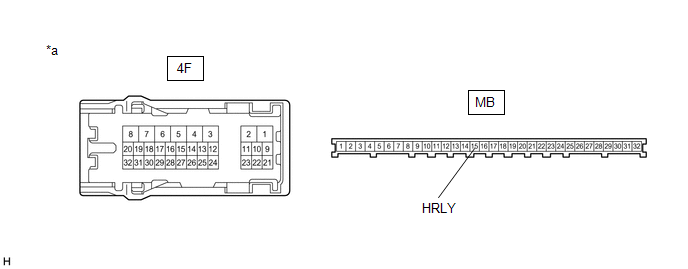
|
*a | Component without harness connected
(Instrument Panel Junction Block Assembly) |
- | - |
(a) Remove the main body ECU (multiplex network body ECU) from the instrument panel junction block assembly.
Click here 
(b) Measure the resistance according to the value(s) in the table below.
Standard Resistance:
|
Tester Connection | Condition |
Specified Condition |
|
4F-31 - MB-15 (HRLY) |
Always | Below 1 Ω |
| OK |
 | REPLACE MAIN BODY ECU (MULTIPLEX NETWORK BODY ECU) |
| NG |
 | REPLACE INSTRUMENT PANEL JUNCTION BLOCK ASSEMBLY |
| 9. |
INSPECT HEADLIGHT ASSEMBLY RH (LO TERMINAL VOLTAGE) |
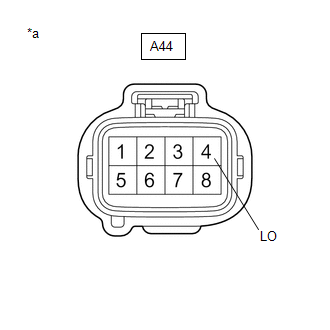
|
*a | Front view of wire harness connector
(to Headlight Assembly RH) |
(a) Disconnect the A44 headlight assembly RH connector.
(b) Measure the voltage according to the value(s) in the table below.
Standard Voltage:
|
Tester Connection | Condition |
Specified Condition |
|
A44-4 (LO) - Body ground |
Light control switch in head position |
11 to 14 V |
| NG |
 | GO TO STEP 11 |
|
OK |
 | |
| 10. |
CHECK HARNESS AND CONNECTOR (HEADLIGHT ASSEMBLY RH - BODY GROUND) |
(a) Measure the resistance according to the value(s) in the table below.
Standard Resistance:
|
Tester Connection | Condition |
Specified Condition |
|
A44-7 (E) - Body ground |
Always | Below 1 Ω |
| OK |
 | REPLACE HEADLIGHT ASSEMBLY RH |
| NG |
 | REPAIR OR REPLACE HARNESS OR CONNECTOR |
| 11. |
CHECK HARNESS AND CONNECTOR (H-LP RH RELAY - HEADLIGHT ASSEMBLY RH) |
(a) Remove the H-LP RH relay.
(b) Measure the resistance according to the value(s) in the table below.
Standard Resistance:
|
Tester Connection | Condition |
Specified Condition |
|
5 (H-LP RH relay) - A44-4 (LO) |
Always | Below 1 Ω |
|
5 (H-LP RH relay) or A44-4 (LO) - Body ground |
Always | 10 kΩ or higher |
| NG |
 | REPAIR OR REPLACE HARNESS OR CONNECTOR |
|
OK |
 | |
| 12. |
INSPECT H-LP RH RELAY |
(a) Inspect the H-LP RH relay.
Click here 
| NG |
 | REPLACE H-LP RH RELAY |
|
OK |
 | |
| 13. |
CHECK HARNESS AND CONNECTOR (POWER SOURCE - H-LP RH RELAY) |
(a) Measure the voltage according to the value(s) in the table below.
Standard Voltage:
|
Tester Connection | Condition |
Specified Condition |
|
1 (H-LP RH relay) - Body ground |
Always | 11 to 14 V |
|
3 (H-LP RH relay) - Body ground |
Always | 11 to 14 V |
| NG |
 | REPAIR OR REPLACE HARNESS OR CONNECTOR |
|
OK |
 | |
| 14. |
CHECK HARNESS AND CONNECTOR (H-LP RH RELAY - MAIN BODY ECU (MULTIPLEX NETWORK BODY ECU)) |
(a) Disconnect the G33 main body ECU (multiplex network body ECU) connector.
(b) Measure the resistance according to the value(s) in the table below.
Standard Resistance:
|
Tester Connection | Condition |
Specified Condition |
|
2 (H-LP RH relay) - G33-12 (HRY2) |
Always | Below 1 Ω |
|
2 (H-LP RH relay) or G33-12 (HRY2) - Body ground |
Always | 10 kΩ or higher |
| OK |
 | REPLACE MAIN BODY ECU (MULTIPLEX NETWORK BODY ECU) |
| NG |
 | REPAIR OR REPLACE HARNESS OR CONNECTOR |
Operation Check
OPERATION CHECK
AUTOMATIC LIGHT CONTROL SYSTEM OPERATION CHECK
NOTICE:
Make sure that the customize settings are set to default when performing the automatic light control system operation check.
Click here 
(a) Turn the engine switch on (IG).
(b) Turn the light control switch to the AUTO position.
(c) Cover the automatic light control sensor.
(d) Check that the taillights and low beam headlights come on.
(e) Uncover the automatic light control sensor.
(f) Check that the low beam headlights and taillights turn off.
LIGHT AUTO TURN-OFF SYSTEM OPERATION CHECK
NOTICE:
Make sure that the customize settings are set to default when performing the light auto turn-off system operation check.
Click here 
(a) When the taillights are on (low beam headlights are not on)
(1) Close all of the doors.
(2) Turn the engine switch on (IG).
(3) Turn the taillights on.
(4) Turn the engine switch off.
(5) Open the driver door.
(6) Check that all of the lights turn off immediately.
(b) When the low beam headlights are on
(1) Close all of the doors.
(2) Turn the engine switch on (IG).
(3) Turn the low beam headlights on.
(4) Turn the engine switch off.
(5) Open any of the doors.
(6) Close the door.
(7) Check that all of the lights turn off after 30 seconds (delay function).
HINT:
Before
the lights turn off, if the lock button on the key is pushed after all
of the doors are locked, all of the lights will turn off immediately.
DAYTIME RUNNING LIGHT SYSTEM OPERATION CHECK
NOTICE:
Make sure that the customize settings are set to default when performing the daytime running light system operation check.
Click here 
(a) Start the engine.
(b)
Turn the light control switch to the tail or AUTO position (with the
low beam headlights not turned on via the automatic light control
system).
(c) Release the parking brake.
(d) Check that the daytime running lights come on.
NOTICE:
Make
sure that the customize settings are set to default when performing the
wiper-linked low beam headlight control system operation check.
Click here

WIPER-LINKED LOW BEAM HEADLIGHT CONTROL SYSTEM OPERATION CHECK
(a) Turn the engine switch on (IG).
(b) Shine a light on the automatic light control sensor.*
HINT:
*:
If troubleshooting is being performed in a bright area, such as outside
on a sunny day, it will not be necessary to perform this step.
(c) Turn the light control switch to the AUTO position.
(d)
Operate the front wipers for 10 seconds or more (except MIST or
washer-linked wiper operation) and check that the low beam headlights*1
or high beam headlights*2 illuminate.
- *1: Dimmer switch high position
- *2: Dimmer switch not high position
WELCOME LIGHT ILLUMINATION CONTROL OPERATION CHECK
NOTICE:
- When operation of the alarm memory function is requested, welcome light illumination control will not operate.
- Make sure that the customize settings are set to their default when
performing the welcome light illumination control operation check.
Click here 
(a) Turn the engine switch off.
(b) Turn the light control switch to the AUTO position.
(c) Cover the automatic light control sensor.
(d) Close and lock all of the doors.
(e) Unlock all of the doors using the wireless door unlock or entry door unlock function.
(f) Check that the taillights, parking lights, front side marker lights and license plate lights illuminate for 15 seconds.
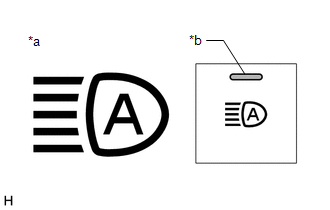
|
*a | Automatic High Beam Indicator Light on Combination Meter Assembly |
|
*b | Auto High Beam Switch Indicator |
AUTOMATIC HIGH BEAM SYSTEM OPERATION CHECK
(a) Check the operation of the automatic high beam indicator light.
(1) Turn the engine switch on (IG).
(2) Turn the light control switch to the AUTO or head position.
(3) Move the dimmer switch to the high position.
(4) Press the auto high beam switch (indicator illuminates).
HINT:
If
the auto high beam switch is turned on when the light control switch is
not in the AUTO or head position, or the dimmer switch is not in the
high position, "Auto High Beam Ready Turn ON High Beam to Activate" will
be displayed on the multi-information display.
(5) Check that the automatic high beam indicator illuminates.
NOTICE:
When
the forward recognition camera cannot correctly detect objects due to
inclement weather such as thick fog or other visual obstructions, the
automatic high beam indicator may not turn on and consequently the
automatic high beam system may not operate.
(b) Check the operation of the automatic high beam function.
(1)
At night, when driving the vehicle with the automatic high beam system
in standby mode, check that the high beams automatically turn on after a
short delay when all of the following conditions are met:
- The vehicle speed is more than approximately 34 km/h (21 mph).
- The area in front of the vehicle is dark.
- There are no oncoming vehicles with headlights on.
- There are no preceding vehicles with taillights on.
- There are few streetlights along the street ahead.
(2) At night, when driving the
vehicle with the high beams turned on by the automatic high beam system,
check that the automatic high beam system turns off the high beams and
returns to standby mode when any of the following conditions are met:
- The vehicle speed is less than approximately 27 km/h (17 mph).
- The level of ambient light is higher than a specified threshold.
- There are oncoming vehicles with headlights on.
- There are preceding vehicles with taillights on.
- Light from streetlights ahead is higher than a specified threshold.
Parts Location
PARTS LOCATION
ILLUSTRATION
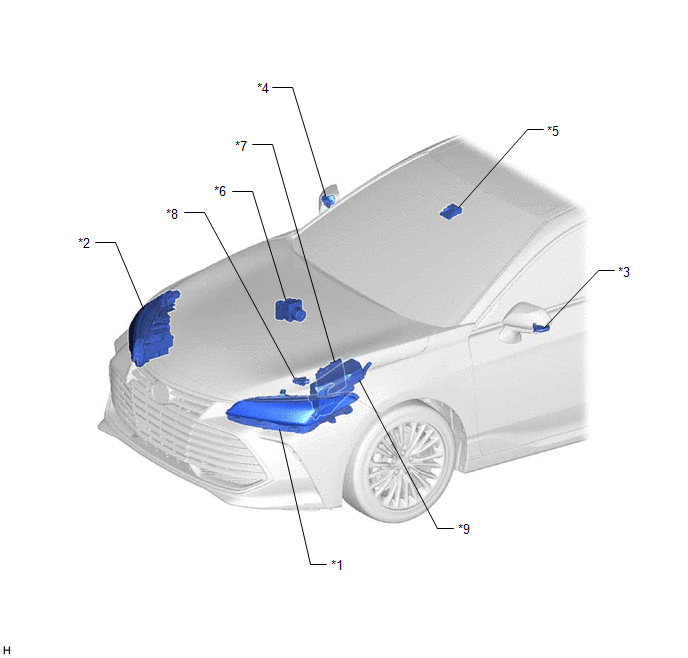
|
*1 | HEADLIGHT ASSEMBLY LH |
*2 | HEADLIGHT ASSEMBLY RH |
|
*3 | SIDE TURN SIGNAL LIGHT ASSEMBLY LH |
*4 | SIDE TURN SIGNAL LIGHT ASSEMBLY RH |
|
*5 | FORWARD RECOGNITION CAMERA |
*6 | SKID CONTROL ECU (BRAKE ACTUATOR ASSEMBLY) |
|
*7 | ECM |
*8 | PARK/NEUTRAL POSITION SWITCH ASSEMBLY |
|
*9 | NO. 1 ENGINE ROOM RELAY BLOCK AND NO. 1 JUNCTION BLOCK ASSEMBLY
- H-LP LH RELAY - H-LP RH RELAY - DIM RELAY - DRL RELAY
- H-LP LH FUSE - H-LP RH FUSE - DRL FUSE - ALT FUSE |
- | - |
ILLUSTRATION
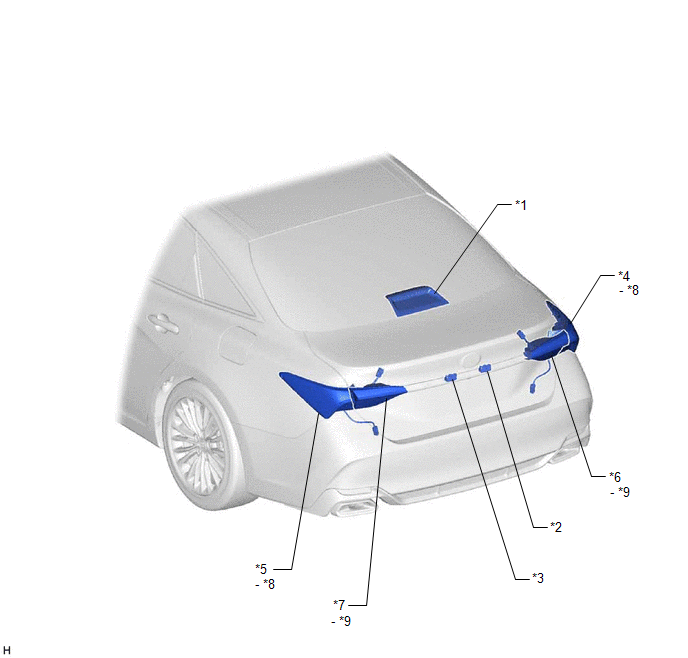
|
*1 | CENTER STOP LIGHT SET |
*2 | LICENSE PLATE LIGHT ASSEMBLY RH |
|
*3 | LICENSE PLATE LIGHT ASSEMBLY LH |
*4 | REAR COMBINATION LIGHT ASSEMBLY RH |
|
*5 | REAR COMBINATION LIGHT ASSEMBLY LH |
*6 | REAR LIGHT ASSEMBLY RH |
|
*7 | REAR LIGHT ASSEMBLY LH |
*8 | REAR COMBINATION LIGHT SOCKET AND WIRE |
|
*9 | REAR LIGHT CORD |
- | - |
ILLUSTRATION
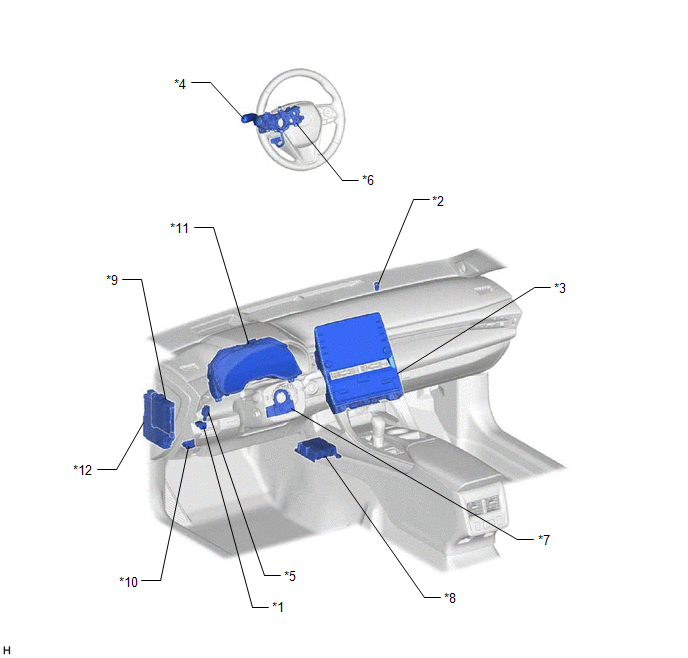
|
*1 | AUTO HIGH BEAM SWITCH |
*2 | AUTOMATIC LIGHT CONTROL SENSOR |
|
*3 | HAZARD WARNING SIGNAL SWITCH (RADIO AND DISPLAY RECEIVER ASSEMBLY) |
*4 | TURN SIGNAL SWITCH |
|
*5 | STOP LIGHT SWITCH ASSEMBLY |
*6 | STEERING WHEEL SWITCH HOUSING |
|
*7 | STEERING SENSOR |
*8 | AIRBAG ECU ASSEMBLY |
|
*9 | MAIN BODY ECU (MULTIPLEX NETWORK BODY ECU) |
*10 | DLC3 |
|
*11 | COMBINATION METER ASSEMBLY |
*12 | INSTRUMENT PANEL JUNCTION BLOCK ASSEMBLY
- TAIL RELAY - BKUP LP RELAY - TAIL FUSE - BKUP LP FUSE
- ECU-IG1 NO. 3 FUSE - ECU-B NO. 2 FUSE - ECU-DCC NO. 2 FUSE
- HAZ FUSE - METER-IG2 FUSE - STOP FUSE - ECU-ACC FUSE |
Precaution
PRECAUTION
PRECAUTION FOR DISCONNECTING CABLE FROM NEGATIVE BATTERY TERMINAL
NOTICE:
When
disconnecting the cable from the negative (-) battery terminal,
initialize the following systems after the cable is reconnected.
|
System Name | See Procedure |
|
Lane Departure Alert System (w/ Steering Control) |
 |
|
Intelligent Clearance Sonar System |
|
Parking Assist Monitor System |
|
Panoramic View Monitor System |
|
Pre-collision System |
|
Lighting System (for Gasoline Model with Cornering Light) |
PRECAUTION FOR AUTOMATIC HIGH BEAM SYSTEM
(a) General Description
The
automatic high beam system is a system that helps ensure visibility by
automatically turning the high beam headlights on and off. Additionally,
due to control limitations of the automatic high beam system, it may be
necessary to manually turn the high beam headlights on and off. For
safety reasons, make sure to turn the high beam headlights on and off
manually according to the driving conditions.
(b) Conditions Unsuitable for Using Automatic High Beam System
Under
the following conditions, the automatic high beam system might not
detect other vehicles or lights correctly, or the high beam headlights
might cause glare or flash pedestrians or the occupants of other
vehicles. Manual operation should be considered.
|
Factor | Condition |
|
Weather/Climate | When driving in bad weather (rain, snow, fog, sandstorms, etc.). |
|
Front windshield |
- When the windshield glass is not clear (ice, snow or frost on the glass).
- When the windshield glass is dirty (sand, mud, water stains or bugs on the glass).
- When the windshield glass is cracked.
- When the windshield glass is fogged-up.
- When the windshield glass has a film attached.
- When an object on the instrument panel reflects off of the windshield glass.
- When any other abnormal conditions exist with the windshield glass.
|
| Forward recognition camera |
- When the forward recognition camera is deformed.
- When the forward recognition camera is dirty.
- When any other abnormal conditions exist with the forward recognition camera.
|
| Nearby vehicles or lights |
- When lights similar to headlights or taillights are in the vicinity of the vehicle.
- When a nearby vehicle has no lights or its lights are off.
- When a vehicle in front has misaligned lights, or its lights are changing color.
- When a vehicle in front has extremely dirty headlights or taillights.
|
| Road conditions |
- When driving in areas where the conditions often change between bright and dark.
- When driving on hilly roads.
- When driving on winding roads or around sharp curves.
- When driving on bumpy roads (cobblestone paving, gravel roads, rough unpaved roads, etc.).
- When highly reflective objects are in front of the vehicle (mirrors, road signs, etc.).
|
| Own vehicle |
- When the headlights are damaged, deformed or dirty.
- When the vehicle posture is abnormal (posture has changed due to the
vehicle being fully loaded, a trailer being towed, road conditions,
etc.).
- When the vehicle has other malfunctions or has been modified.
|
| Automatic high beam system |
Malfunction: When
the automatic high beam indicator light on the combination meter
assembly is off and "Headlight System Malfunction Visit Your Dealer" is
displayed on the multi-information display. Others:
- When the automatic high beam system does not seem to be turning the high beam headlights on and off properly.
- When the automatic high beam system is frequently turning the high beam headlights on and off.
- When the glare from the high beam headlights would disturb pedestrians or the drivers of other vehicles.
|
PRECAUTION FOR FRONT CAMERA SYSTEM
Click here 
Problem Symptoms Table
PROBLEM SYMPTOMS TABLE
NOTICE:
- Before replacing the main body ECU (multiplex network body ECU), refer to Registration.
Click here 
- When replacing the combination meter assembly, always replace it with a
new one. If a combination meter assembly which was installed to another
vehicle is used, the information stored in it will not match the
information from the vehicle and a DTC may be stored.
HINT:
Use the
table below to help determine the cause of problem symptoms. If multiple
suspected areas are listed, the potential causes of the symptoms are
listed in order of probability in the "Suspected Area" column of the
table. Check each symptom by checking the suspected areas in the order
they are listed. Replace parts as necessary.
Headlight |
Symptom | Suspected Area |
Link |
| Left low beam headlight does not illuminate |
Refer to "LO-beam Headlight does not Illuminate" |
 |
|
Right low beam headlight does not illuminate |
Refer to "LO-beam Headlight does not Illuminate" |
 |
|
Both left and right low beam headlights do not illuminate |
Headlight dimmer switch circuit |
 |
|
Main body ECU (Multiplex network body ECU) |
 |
|
Left high beam headlight does not illuminate |
Headlight assembly LH |
 |
|
Harness or connector |
- |
|
Right high beam headlight does not illuminate |
Headlight assembly RH |
 |
|
Harness or connector |
- |
|
Both left and right high beam headlights do not illuminate |
Headlight dimmer switch circuit |
 |
|
High beam headlight circuit |
 |
|
Main body ECU (Multiplex network body ECU) |
 |
|
High Flash (passing function) does not operate (high beam headlights are normal) |
Headlight dimmer switch circuit |
 |
|
Main body ECU (Multiplex network body ECU) |
 |
Parking Light |
Symptom | Suspected Area |
Link |
|
Left parking light does not illuminate |
Headlight assembly LH |
 |
|
Harness or connector |
- |
|
Right parking light does not illuminate |
Headlight assembly RH |
 |
|
Harness or connector |
- |
|
Both left and right parking lights do not illuminate |
Taillight relay circuit |
 |
|
Harness or connector |
- |
Front Side Marker Light |
Symptom | Suspected Area |
Link |
|
Left front side marker light does not illuminate |
Headlight assembly LH |
 |
|
Harness or connector |
- |
|
Right front side marker light does not illuminate |
Headlight assembly RH |
 |
|
Harness or connector |
- |
|
Both left and right front side marker lights do not illuminate |
Taillight relay circuit |
 |
|
Harness or connector |
- |
Daytime Running Light |
Symptom | Suspected Area |
Link |
|
Left daytime running light does not illuminate |
Headlight assembly LH |
 |
|
Harness or connector |
- |
|
Right daytime running light does not illuminate |
Headlight assembly RH |
 |
|
Harness or connector |
- |
|
Both left and right daytime running lights do not illuminate |
Check customize settings |
 |
|
Daytime running light circuit |
 |
|
Headlight dimmer switch circuit |
 |
|
IG signal circuit |
 |
|
CAN communication system |
 |
|
Main body ECU (Multiplex network body ECU) |
 |
Taillight |
Symptom | Suspected Area |
Link |
|
Left or right taillight (rear combination light assembly) does not illuminate |
Rear combination light assembly |
 |
|
Rear combination light socket and wire |
 |
|
Harness or connector |
- |
|
Left or right taillight (rear light assembly) does not illuminate |
Rear light assembly |
 |
|
Rear light cord |
 |
|
Harness or connector |
- |
|
All
of the taillights, parking lights, front side marker light, license
plate lights and rear side marker lights do not illuminate |
Headlight dimmer switch circuit |
 |
|
Taillight relay circuit |
 |
|
Main body ECU (Multiplex network body ECU) |
 |
Rear Side Marker Light |
Symptom | Suspected Area |
Link |
|
Left or right rear side marker light does not illuminate |
Rear combination light assembly |
 |
|
Rear combination light socket and wire |
 |
License Plate Light |
Symptom | Suspected Area |
Link |
|
License plate light does not illuminate |
License plate light assembly |
 |
|
Harness or connector |
- |
Stop Light |
Symptom | Suspected Area |
Link |
|
Left or right stop light does not illuminate |
Rear combination light assembly |
 |
|
Rear combination light socket and wire |
 |
|
Harness or connector |
- |
|
All of the stop lights do not illuminate |
STOP fuse | - |
|
Stop light switch assembly |
 |
|
Harness or connector |
- |
High Mounted Stop Light |
Symptom | Suspected Area |
Link |
|
High mounted stop light does not illuminate |
Center stop light set |
 |
|
Harness or connector |
- |
Back-up Light |
Symptom | Suspected Area |
Link |
|
Left or right back-up light does not illuminate |
Rear light assembly |
 |
|
Rear light cord |
 |
|
Harness or connector |
- |
|
Both left and right back-up lights do not illuminate |
BKUP LP fuse | - |
|
ECU-ACC fuse | - |
|
Park/neutral position switch assembly |
 |
|
Instrument panel junction block assembly |
 |
|
Harness or connector |
- |
Turn Signal Light |
Symptom | Suspected Area |
Link |
|
Left or right front turn signal light does not operate |
Headlight assembly |
 |
|
Harness or connector |
- |
|
Left or right rear turn signal light does not operate |
Rear combination light assembly |
 |
|
Rear combination light socket and wire |
 |
|
Harness or connector |
- |
|
Left or right side turn signal light does not operate |
Side turn signal light assembly |
 |
|
Outer rear view mirror assembly |
 |
|
Harness or connector |
- |
|
Turn signal lights do not operate in one direction |
Turn signal switch circuit |
 |
|
Meter/gauge system |
 |
|
All turn signal lights do not operate |
Turn signal switch circuit |
 |
|
Combination meter assembly |
 |
|
All turn signal lights do not flash at the correct speed |
Combination meter assembly |
 |
Hazard Warning Signal Light |
Symptom | Suspected Area |
Link |
|
Hazard warning signal lights do not operate |
Hazard warning switch circuit |
 |
|
Combination meter assembly |
 |
Automatic Light Control System |
Symptom | Suspected Area |
Link |
|
Automatic light control system does not operate |
Headlight dimmer switch circuit |
 |
|
Main body ECU (Multiplex network body ECU) |
 |
Light Auto Turn-off System |
Symptom | Suspected Area |
Link |
|
Light auto turn-off system does not operate |
Headlight dimmer switch circuit |
 |
|
IG signal circuit |
 |
|
Front door courtesy switch circuit |
 |
|
Main body ECU (Multiplex network body ECU) |
 |
Remote Operation Function (w/ Telematics System) |
Symptom | Suspected Area |
Link |
| Lights do not operate using remote operation function (lighting system is normal) |
Telematics system |
 |
Wiper-linked Low Beam Headlight Control System |
Symptom | Suspected Area |
Link |
|
Wiper-linked low beam headlight control system does not operate |
Check customize settings |
 |
|
Main body ECU (Multiplex network body ECU) |
 |
Welcome Light Illumination Control |
Symptom | Suspected Area |
Link |
|
Welcome light illumination control does not operate |
Check customize settings |
 |
|
Main body ECU (Multiplex network body ECU) |
 |
Automatic High Beam System |
Symptom | Suspected Area |
Link |
|
Automatic
high beam system does not operate or automatic high beam indicator does
not illuminate (low beam headlights and high beam headlights are
normal) | Check millimeter wave radar sensor assembly |
 |
|
Check Data List (High Temperature Status1) |
|
Check automatic high beam indicator light |
|
Check Data List (Auto H Beam STS0) |
|
Perform Active Test (Multi Display All (White)) |
|
Auto high beam switch |
|
Harness or connector |
|
Combination meter assembly |
|
Forward recognition camera |
|
Main body ECU (Multiplex network body ECU) |
|
Auto high beam switch indicator does not come ON |
Refer to "Automatic High Beam Switch Indicator does not Come ON" |
 |
Taillight Relay Circuit
DESCRIPTION
The main body ECU (multiplex network body ECU) controls the operation of the TAIL relay.
WIRING DIAGRAM
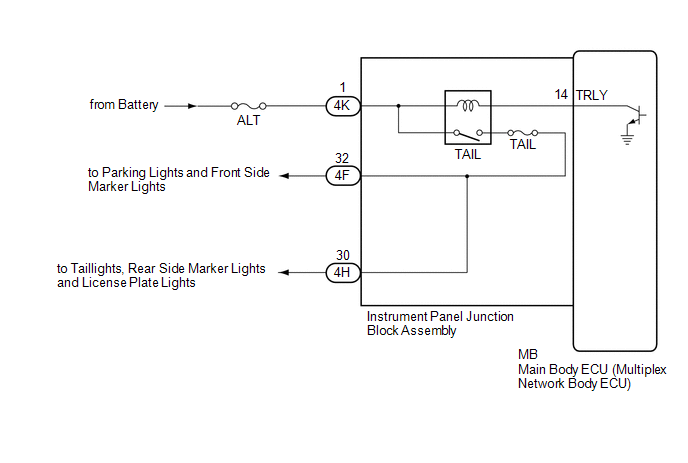
CAUTION / NOTICE / HINT
NOTICE:
- Inspect the fuses for circuits related to this system before performing the following procedure.
- Before replacing the main body ECU (multiplex network body ECU), refer to Registration.
Click here 
PROCEDURE
|
1. | PERFORM ACTIVE TEST USING TECHSTREAM |
(a) Connect the Techstream to the DLC3.
(b) Turn the engine switch on (IG).
(c) Turn the Techstream on.
(d) Enter the following menus: Body Electrical / Main Body / Active Test.
(e) Perform the Active Test according to the display on the Techstream.
Body Electrical > Main Body > Active Test
|
Tester Display | Measurement Item |
Control Range | Diagnostic Note |
|
Taillight Relay | Taillight relay |
OFF or ON | - |
Body Electrical > Main Body > Active Test
|
Tester Display |
| Taillight Relay |
OK:
Taillights illuminate.
| OK |
 | PROCEED TO NEXT SUSPECTED AREA SHOWN IN PROBLEM SYMPTOMS TABLE |
|
NG |
 | |
| 2. |
CHECK HARNESS AND CONNECTOR (POWER SOURCE - INSTRUMENT PANEL JUNCTION BLOCK ASSEMBLY) |
(a) Disconnect the 4K instrument panel junction block assembly connector.
(b) Measure the voltage according to the value(s) in the table below.
Standard Voltage:
|
Tester Connection | Condition |
Specified Condition |
|
4K-1 - Body ground | Always |
11 to 14 V |
| NG |
 | REPAIR OR REPLACE HARNESS OR CONNECTOR |
|
OK |
 | |
| 3. |
INSPECT INSTRUMENT PANEL JUNCTION BLOCK ASSEMBLY |
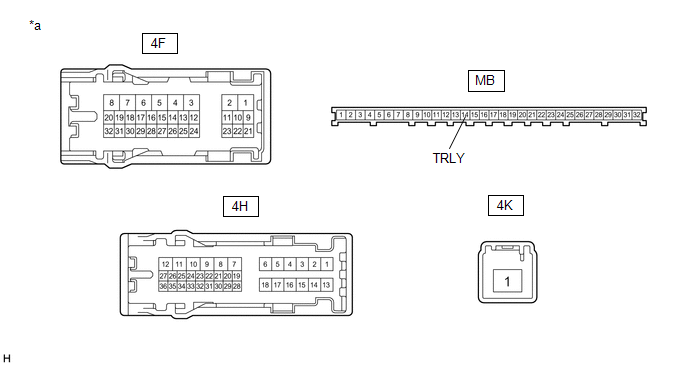
|
*a | Component without harness connected
(Instrument Panel Junction Block Assembly) |
- | - |
(a) Remove the main body ECU (multiplex network body ECU) from the instrument panel junction block assembly.
Click here 
(b) Connect a positive (+) lead from the battery to terminal 4K-1.
(c) Connect a negative (-) lead from the battery to terminal MB-14 (TRLY).
(d) Measure the voltage according to the value(s) in the table below.
Standard Voltage:
|
Tester Connection | Condition |
Specified Condition |
|
4F-32 - Battery negative (-) terminal |
Always | 11 to 14 V |
|
4H-30 - Battery negative (-) terminal |
Always | 11 to 14 V |
| OK |
 | REPLACE MAIN BODY ECU (MULTIPLEX NETWORK BODY ECU) |
| NG |
 | REPLACE INSTRUMENT PANEL JUNCTION BLOCK ASSEMBLY |
Terminals Of Ecu
TERMINALS OF ECU
CHECK MAIN BODY ECU (MULTIPLEX NETWORK BODY ECU) AND INSTRUMENT PANEL JUNCTION BLOCK ASSEMBLY
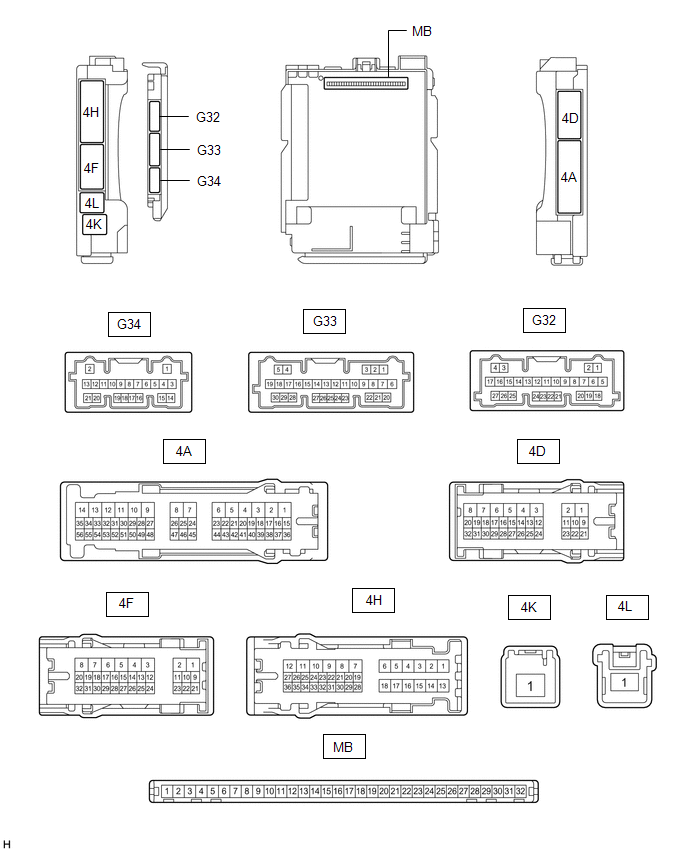
(a) Disconnect the instrument panel junction block assembly and main body ECU (multiplex network body ECU) connectors.
(b) Measure the voltage and resistance according to the value(s) in the table below.
|
Terminal No. (Symbol) | Wiring Color |
Terminal Description | Condition |
Specified Condition |
|
4D-3 - Body ground | LA - Body ground |
Ground | Always |
Below 1 Ω |
|
4F-1 - Body ground | LG - Body ground |
Battery power supply | Always |
11 to 14 V |
|
4K-1 - Body ground | W - Body ground |
Battery power supply | Always |
11 to 14 V |
(c) Connect the instrument panel junction block assembly and main body ECU (multiplex network body ECU) connectors.
(d) Measure the voltage and resistance, and check for pulses according to the value(s) in the table below.
|
Terminal No. (Symbol) | Wiring Color |
Terminal Description | Condition |
Specified Condition |
|
4F-19 - Body ground |
BE - Body ground |
BKUP LP relay drive output |
Engine switch off, reverse (R) not selected |
Below 1 V |
| Engine switch on (IG), reverse (R) selected |
11 to 14 V |
|
4F-28 - Body ground |
GR - Body ground |
Daytime running light system drive output |
Daytime running light system operating |
Below 1 V |
| Daytime running light system not operating |
11 to 14 V |
|
4F-31 - Body ground |
V - Body ground | H-LP LH relay drive output |
Light control switch in head position |
Below 1 V |
| Taillights off |
11 to 14 V |
|
4F-32 - Body ground |
LA-B - Body ground | Parking lights and front side marker lights drive output |
Taillights on | 11 to 14 V |
|
Taillights off | Below 1 V |
|
4H-10 - Body ground |
LG - Body ground |
Back-up lights drive output |
Engine switch off, reverse (R) not selected |
Below 1 V |
| Engine switch on (IG), reverse (R) selected |
11 to 14 V |
|
4H-30 - Body ground |
LA-B - Body ground |
Taillights, rear side marker lights and license plate lights drive output |
Taillights on | 11 to 14 V |
|
Taillights off | Below 1 V |
|
G32-19 (GND2) - Body ground |
W-B - Body ground | Ground |
Always | Below 1 Ω |
|
G32-23 (AHID) - Body ground |
BE - Body ground |
Auto high beam switch indicator drive output |
Engine switch on (IG), auto high beam switch on |
Below 1 V |
| Engine switch on (IG), auto high beam switch off |
11 to 14 V |
|
G33-12 (HRY2) - Body ground |
BE - Body ground | H-LP RH relay drive output |
Light control switch in head position |
Below 1 V |
| Taillights off |
11 to 14 V |
|
G33-13 (DIM) - Body ground |
G - Body ground | High beam headlight drive output |
Light control switch in head position and dimmer switch in high or high flash position |
Below 1 V |
| Dimmer switch not in high or high flash position |
11 to 14 V |
|
G33-16 (HEAD) - Body ground |
LG - Body ground | Light control switch head position input |
Light control switch in head position |
Below 1 V |
| Light control switch not in head position |
11 to 14 V |
|
G33-23 (CLTB) - G33-25 (CLTE) |
BE - GR | Automatic light control sensor power supply output |
Engine switch off | Below 1 V |
|
Engine switch on (IG) |
11 to 14 V |
|
G33-24 (CLTS) - Body ground |
R - Body ground |
Automatic light control sensor signal input |
Engine switch off | Below 1 V |
|
Engine switch on (IG) |
Pulse generation (See waveform 1) |
|
G33-26 (AHBI) - Body ground |
B - Body ground | Auto high beam switch signal input |
Auto high beam switch on |
Below 1 V |
| Auto high beam switch off |
11 to 14 V |
(1) Waveform 1
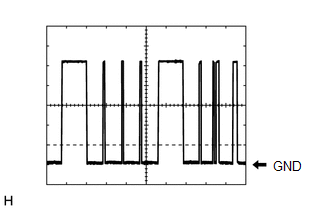
|
Item | Content |
|
Tester Connection | G33-24 (CLTS) - Body ground |
|
Tool setting | 2 V/DIV., 10 ms./DIV. |
|
Condition | Engine switch on (IG) |
HINT:
The communication waveform changes according to the surrounding brightness.
CHECK COMBINATION METER ASSEMBLY
Click here

CHECK FORWARD RECOGNITION CAMERA
Click here

CHECK STEERING SENSOR
Click here

Turn Signal Switch Circuit
DESCRIPTION
The steering sensor receives the turn signal switch information and controls the turn signal lights.
WIRING DIAGRAM
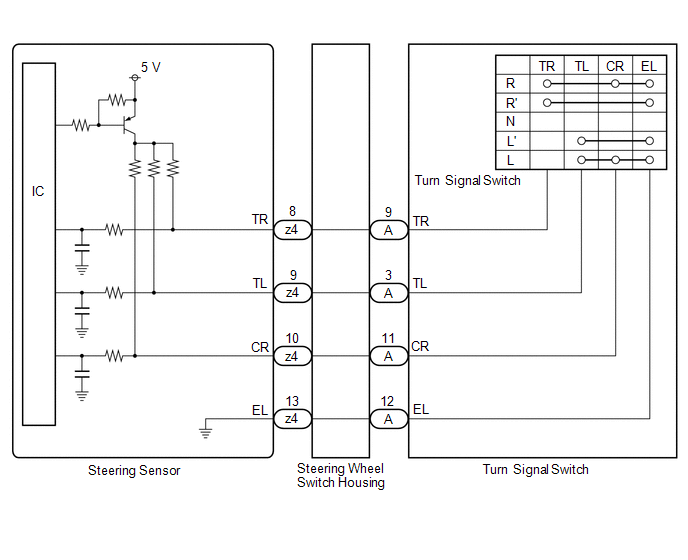
PROCEDURE
| 1. |
READ VALUE USING TECHSTREAM |
(a) Connect the Techstream to the DLC3.
(b) Turn the engine switch on (IG).
(c) Turn the Techstream on.
(d) Enter the following menus: Chassis / Steering Angle Sensor / Data List.
(e) Read the Data List according to the display on the Techstream.
Chassis > Steering Angle Sensor > Data List
|
Tester Display | Measurement Item |
Range | Normal Condition |
Diagnostic Note |
|
Turn Signal Switch (Right) |
Turn signal switch (right turn position) signal |
OFF or ON | OFF: Turn signal switch not in right turn position
ON: Turn signal switch in right turn position |
- |
| Turn Signal Switch (Left) |
Turn signal switch (left turn position) signal |
OFF or ON | OFF: Turn signal switch not in left turn position
ON: Turn signal switch in left turn position |
- |
| Cornering Light/Front Side Illuminate Light Switch |
Turn signal switch (full turn) signal |
OFF or ON | OFF: Turn signal switch not in left or right turn position
ON: Turn signal switch in left or right full turn position |
- |
Chassis > Steering Angle Sensor > Data List
|
Tester Display |
| Turn Signal Switch (Right) |
|
Turn Signal Switch (Left) |
|
Cornering Light/Front Side Illuminate Light Switch |
OK:
Normal conditions listed above are displayed.
| OK |
 | PROCEED TO NEXT SUSPECTED AREA SHOWN IN PROBLEM SYMPTOMS TABLE |
|
NG |
 | |
| 2. |
INSPECT TURN SIGNAL SWITCH |
(a) Remove the turn signal switch.
Click here 
(b) Inspect the turn signal switch.
Click here 
| NG |
 | REPLACE TURN SIGNAL SWITCH |
|
OK |
 | |
| 3. |
INSPECT STEERING WHEEL SWITCH HOUSING |
(a) Remove the steering wheel switch housing.
Click here

(b) Inspect the steering wheel switch housing.
Click here 
| OK |
 | REPLACE STEERING SENSOR |
| NG |
 | REPLACE STEERING WHEEL SWITCH HOUSING |
























































































































































































































































































